#Davis and Marshall 1974
Text
Finding II. ~Relevant to Management Determination for the Everglades Agricultural Area, Draft Copy, 1975
Toxic Lake Okeechobee, June 11, 2023 , Ed Lippisch
Today I share Finding II. of “Conclusions of the Special Project to Prevent the Eutrophication of Lake Okeechobee Relevant to Management Determination for the Everglades Agricultural Area,” Draft Copy, 1975.
This information was gathered by my husband and I at the State Library and Archives of Florida in Tallahassee.
I recently I posted Finding…

View On WordPress
#" Draft Copy#1975.#Brezonik#Conclusions of the Special Project to Prevent the Eutrophication of Lake Okeechobee Relevant to Management Determination for the Everglades#Davis and Marshall 1974#Everglades Agricultural Area remains responsible for damages that plague Lake Okeechobee TODAY.#Finding II. "Water backpumped from the EAA contributes significantly to the cultural eutrophication of Lake Okeechobee" 1975#lake okeechobee history#when did back pumping stop in the EAA#When did packpuming get challenged in Florida
1 note
·
View note
Text
AEW Roster Organized By Age (& events, for context)
Source: Smackdown Hotel
Jan 3 1952 - Jim Ross
Feb 8 1952 - Elizabeth II crowned
May 30 1955 - Jake Roberts
Nov 3 1957 - Laika becomes first animal in space
Nov 7 1957 - Tony Schiavone
May 13 1958 - Velcro is patented
Sep 20 1958 - Arn Anderson
Mar 20 1959 - Sting
Jun 12 1963 - Jerry Lynn
Jul 1 1963 - ZIP codes are introduced in the US
Oct 13 1963 - Don Callis
Nov 11 1963 - Daddy Ass
Apr 14 1967 - Jeff Jarrett
May 9 1967 - Kevin Kelly
Oct 11 1967 - Taz
Dec 6 1967 - First successful heart transplant
May 10 1968 - William Regal
Oct 30 1968 - Luther
Apr 10 1969 - Dustin Rhodes
Jul 16 1969 - Apollo 11 lands the first people on the moon
Mar 24 1970 - Christopher Daniels
Nov 9 1970 - Chris Jericho
Dec 18 1970 - Rob Van Dam
Apr 3 1971 - Alex Marvez
Jun 12 1971 - Mark Henry
Feb 8 1972 - Paul Wight
Oct 12 1972 - Karen Jarrett
Nov 29 1972 - Atari releases Pong
Oct 30 1973 - Adam Copeland
Nov 30 1973 - Christian Cage
Jan 1 1974 - Jim Ross starts his career in wrestling
Sep 23 1974 - Matt Hardy
Oct 8 1975 - Michael Nakazawa
Jan 23 1976 - Nigel McGuinness
May 8 1976 - First roller coaster with a loop in it opens
Oct 4 1976 - Emi Sakura
Feb 28 1977 - Lance Archer
Aug 31 1977 - Jeff Hardy
Nov 9 1977 - Alex Abrahantes
Dec 12 1977 - The Butcher
Mar 17 1979 - Samoa Joe
Aug 1 1979 - Prince Nana
Oct 3 1979 - Johnny TV
Dec 29 1979 - Justin Roberts
May 6 1980 - Colt Cabana
Jun 2 1980 - The Blade
Jul 16 1980 - Excalibur
Nov 17 1980 - Mercedes Martinez
Dec 27 1980 - Claudio Castagnoli
Feb 19 1981 - Shawn Spears
May 22 1981 - Bryan Danielson
Aug 1 1981 - MTV debuts
Dec 12 1981 - Eddie Kingston
Apr 7 1982 - Sonjay Dutt
May 21 1982 - Kota Ibushi
Aug 3 1982 - Nyla Rose
Oct 10 1982 - Tony Khan
Dec 3 1982 - Jake Hager
Mar 1 1983 - Mark Sterling
Mar 19 1983 - Matt Sydal
Apr 1 1983 - Scorpio Sky
Jul 26 1983 - Roderick Strong
Oct 16 1983 - Kenny Omega
Dec 7 1983 - Matt Menard
Jan 26 1984 - JD Drake
Feb 2 1984 - Brian Cage
Feb 17 1984 - Jimmy Jacobs
Feb 23 1984 - Serpentico
Mar 20 1984 - Angelo Parker
May 4 1984 - Orange Cassidy
Jun 30 1984 - Dax Harwood
Jul 1 1984 - PG13 rating is invented
Sep 19 1984 - Renee Paquette
Nov 4 1984 - Ryan Nemeth
Nov 8 1984 - Keith Lee
Dec 26 1984 - Pat Buck
Dec 29 1984 - Anthony Henry
Jan 17 1985 - Mark Briscoe
Feb 13 1985 - Truth Magnum
Feb 26 1985 - Penta El Zero Miedo
Mar 13 1985 - Matt Jackson
Mar 19 1985 - Luchasaurus
Mar 20 1985 - Matt Taven
Mar 23 1985 - CJ
Mar 31 1985 - First Wrestlemania
May 16 1985 - Mike Bennett
May 19 1985 - Malakai Black
Apr 20 1985 - Jay Lethal
Jul 15 1985 - QT Marshall
Aug 6 1985 - Tony Nese
Sep 9 1985 - The Bunny
Dec 7 1985 - Jon Moxley
Dec 25 1985 - Miro
Jan 24 1986 - Vincent
Feb 5 1986 - Madison Rayne
Feb 19 1986 - Shawn Dean
Feb 21 1986 - The first Zelda game is released
Mar 2 1986 - Bishop Kaun
Mar 4 1986 - Dalton Castle
Apr 8 1986 - Big Bill
Apr 22 1986 - Chuck Taylor
Jun 15 1986 - Cezar Bononi
Jun 29 1986 - Serena Deeb
Jul 22 1986 - Thunder Rosa
Aug 21 1986 - Pac
Oct 22 1986 - Taya Valkyrie
Jan 13 1987 - Ian Riccaboni
Feb 4 1987 - Aaron Solo
Mar 1 1987 - Kyle O'Reilly
Mar 7 1987 - Angelico
Mar 10 1987 - Alex Reynolds
Mar 17 1987 - Brody King
Mar 30 1987 - Trent Beretta
May 17 1987 - Cash Wheeler
Apr 21 1987 - Dutch
Jun 18 1987 - Brandon Cutler
Jul 20 1987 - Evil Uno
Sep 5 1987 - AR Fox
Jan 19 1988 - Wardlow
Mar 20 1988 - Josh Woods
Apr 14 1988 - Marina Shafir
Apr 17 1988 - Dasha Gonzalez
Jun 11 1988 - Hikaru Shida
Jul 18 1988 - RJ City
Aug 23 1988 - Metalik
Aug 28 1988 - EJ Nduka
Aug 31 1988 - Athena
Sep 26 1988 - Buddy Matthews
Sep 29 1988 - Rush
Nov 24 1988 - Anthony Ogogo
Jan 25 1989 - Stu Grayson
Apr 10 1989 - Juice Robinson
Apr 11 1989 - Ari Daivari
Jun 14 1989 - Peter Avalon
Jul 5 1989 - Adam Cole
Jul 27 1989 - Nick Jackson
Jul 31 1989 - Max Caster
Sep 20 1989 - Ethan Page
Nov 3 1989 - Andrade El Idolo
Dec 17 1989 - The Simpsons premiers
Aug 17 1990 - Danhausen
Aug 20 1990 - Mark Davis
Sep 30 1990 - Swerve Strickland
Nov 12 1990 - Stokely Hathaway
Dec 18 1990 - Anthony Bowens
Dec 30 1990 - Rey Fenix
Jan 9 1991 - Ruby Soho
Jan 23 1991 - Powerhouse Hobbs
Jan 30 1991 - Toa Liona
Feb 4 1991 - Mike Santana
Apr 22 1991 - Nick Comoroto
Apr 23 1991 - Dr Britt Baker DMD
May 18 1991 - Colten Gunn
Jun 4 1991 - John Silver
Jul 14 1991 - Diamante
Jul 21 1991 - Adam Page
Aug 23 1991 - World Wide Web starts up
Sep 27 1991 - Ortiz
Nov 22 1991 - Brandon
Nov 22 1991 - Brent
Jan 15 1992 - Preston Vance
Apr 7 1992 - Abadon
May 19 1992 - Kip Sabian
Jun 3 1992 - Red Velvet
Aug 17 1992 - Saraya
Sep 14 1992 - Penelope Ford
Sep 15 1992 - Dralistico
Oct 9 1992 - Jay White
Dec 27 1992 - Yuka Sakazaki
Jan 7 1993 - Darby Allin
Jul 28 1993 - Sammy Guevara
Jan 25 1994 - Willow Nightingale
Feb 21 1994 - Ricky Starks
Mar 26 1994 - Paige Vanzant
Apr 12 1994 - Marq Quen
Jun 6 1994 - Lee Moriarty
Aug 26 1994 - Austin Gunn
Sep 16 1994 - Kiera Hogan
Apr 17 1995 - Bandido
Apr 23 1995 - Jamie Hayter
May 29 1995 - Konosuka Takeshita
Jun 6 1995 - Tay Melo
Aug 7 1995 - Kris Statlander
Oct 19 1995 - Toni Storm
Nov 13 1995 - Boulder
Nov 13 1995 - Bronson
Nov 22 1995 - Toy Story is released
Dec 10 1995 - Satnam Singh
Mar 15 1996 - MJF
Aug 11 1996 - Lexy Nair
Oct 26 1996 - Wheeler Yuta
Apr 29 1997 - El Hijo Del Vikingo
Jun 4 1997 - Riho
Jun 15 1997 - Jack Perry
Jul 10 1997 - Isiah Kassidy
Oct 27 1997 - Leyla Hirsch
Dec 13 1997 - Lee Johnson
Mar 9 1998 - Parker Boudreaux
Jul 15 1998 - Anna Jay
Aug 4 1998 - Mariah May
Sep 7 1998 - Daniel Garcia
Dec 15 1998 - Komander
Dec 24 1998 - Kyle Fletcher
May 4 1999 - Hook
Sep 20 1999 - Darius Martin
Oct 2 1999 - Skye Blue
Mar 3 2001 - Dante Martin
Mar 23 2001 - WWF buys WCW
Nov 8 2001 - Julia Hart
Oct 13 2004 - Billie Starkz
Jul 10 2005 - Nick Wayne
Jan 17 2012 - Negative One
#it is now law that whoever's name is higher gets to call whoever's name is lower an infant#or a child#or a baby#as is law whenever you're older than anyone#also if anyone is missing SDH didn't have their birthday#i think I just wanted to roast JR for being old as fuck#AEW#please appreciate this it took days and now I have like 90 tabs open#of wikipedia articles that I want to read after doing the research here
16 notes
·
View notes
Text
LÉGENDES DU JAZZ
SONNY FORTUNE, LE DERNIER DES GUERRIERS
"Well, Sonny left it all on the bandstand, right up until the end."
- Reggie Marshall
Né le 19 mai 1939 à Philadelphie, en Pennsylvanie, Sonny Cornelius Fortune était le fils de Cornelius et Margaret Fortune. Le père de Fortune était chauffeur de camion. Malgré ses origines modestes, Fortune avait grandi dans un environnement où la musique était à l’honneur.
Fortune avait débuté dans la musique comme chanteur à l’adolescence. Fortune, qui adorait le rhythm & blues, avait modelé son style sur celui de ses groupes favoris des années 1950, les Spaniels, les Drifters et les Clovers.
Fortune était passé au saxophone à la fin de l’adolescence. Fortune avait étudié à la Granoff School of Music, où il avait eu comme camarades de classe de futurs grands noms du jazz comme John Coltrane et Dizzy Gillespie. Durant ses études, Fortune avait aussi décroché quelques contrats avec des groupes de rhythm & blues locaux.
Fortune avait été soumis très tôt aux responsabilités de la vie adulte. Marié dès l’âge de seize ans, il était déjà père de deux enfants deux ans plus tard. Fortune avait dix-huit ans lorsqu’il avait commencé à s’intéresser au jazz. La même année, son père avait fait le premier paiement sur son premier saxophone alto. Au début, Fortune s’attendait à maîtriser son instrument en seulement six mois. Lorsqu’il s’était aperçu que ce ne serait pas aussi facile qu’il le croyait, il avait rangé son saxophone dans un sac et ne l’avait pas ressorti avant un an. C’est à ce moment-là qu’il avait découvert John Coltrane. Il expliquait: “I became very disciplined. It was listening to John Coltrane’s ‘My Favorite Things’ that turned me around. His playing was about Black thought.”
Parmi les premières influences de Fortune, on remarquait aussi Charlie Parker et Sonny Rollins.
DÉBUTS DE CARRIÈRE
Fortune avait amorcé sa carrière en 1965 lorsqu’il avait co-dirigé une session de soul-jazz avec l’organiste Stan Hunter.
Après la mort de Coltrane en 1967, Fortune s’était installé à New York et s’était joint au groupe du batteur Elvin Jones. C’est d’ailleurs Coltrane qui avait recommandé Fortune à Jones peu avant sa mort. Fortune se produisait avec le groupe de Jones au Pookie’s Pub de Lower Manhattan lorsqu’il avait appris la mort de son mentor.
Durant cette période, avait aussi joué avec le saxophoniste Frank Foster. Décrivant son arrivée à New York, Fortune avait commenté: "Eventually, in order to find out if you really have what it takes, you have to go to the center, and that's New York...you can only do so much in your hometown."
De 1968 à 1969, Fortune avait accompagné le percussionniste afro-cubain Mongo Santamaría. Après s’être installé à Los Angeles en 1970, il avait brièvement joué avec le big band de Buddy Rich avec qui il avait enregistré un album en concert.
Après avoir passé sept mois en Californie, Fortune avait accompagné le chanteur d’avant-garde Leon Thomas avant de se joindre au groupe du pianiste McCoy Tyner dont il avait fait partie de 1971 à 1975. Le talent d’innovateur de Fortune était particulièrement mis en évidence sur les albums de Tyner ‘’Sahara’’ (1972), ‘’Song for My Lady’’ (1973) et ‘’Song of the New World’’ (1973).
En septembre 1974, Fortune avait été contacté par Miles Davis, qui lui avait proposé de remplacer le saxophoniste Dave Liebman avec son groupe. Même s’il avait déjà décliné une offre similaire pour demeurer avec le groupe de Tyner, Fortune n’avait pu laisser passer l’occasion de faire quelque chose de complètement différent. Fortune avait fait partie du groupe de Davis jusqu’au printemps 1975, alors qu’il avait cédé la place à Sam Morrison. Avec Davis, Fortune avait collaboré aux albums Big Fun (1974), Get Up With It (1974), Agharta et Pangaea (tous deux enregistrés au Japon en 1975). Décrivant sa collaboration avec le groupe de Davis, Fortune avait commenté: “Miles was definitely one of my heroes. It was an unbelievable experience. The music he was playing was somewhat out of my realm, but it was Miles.”
Après avoir quitté le groupe de Davis, Fortune avait joué avec le trompettiste Nat Adderley avant de former son propre groupe la même année.
Fortune avait enregistré un premier album comme leader en 1974 sous le titre de ‘’Long Before Our Mothers Cried.’’ L’album, qui avait été enregistré avec un groupe composé du trompettiste Charles Sullivan et du pianiste Stanley Cowell, mettait notamment en vedette une section de percussionnistes d’origine africaine et afro-cubaine.
La pièce-titre était une des cinq compositions de Fortune qui figuraient sur l’album. Fortune avait utilisé sensiblement les mêmes musiciens sur ses deux albums suivants intitulés respectivement Awakening (1975) et Waves of Dreams (1976) qui avaient été acclamés par la critique. Fortune avait enchaîné par la suite avec deux albums de jazz-fusion, Serengeti Minstrel (1977) et Infinity Is (1978), qui incorporaient des éléments de funk et de disco. En 1977, Fortune avait également fait une apparition sur l’album live The Atlantic Family Live at Montreux.
DERNIÈRES ANNÉES
Même s’il avait beaucoup moins enregistré dans les années 1980, Fortune avait fait un retour au milieu des années 1990, et avait enregistré plusieurs albums pour Blue Note. Parmi ces albums, on remarquait un hommage à Thelonious Monk intitulé Four in One (1994) qui mettait en vedette Kirk Lightsey au piano. En septembre 1995, Fortune avait enchaîné avec A Better Understanding, un album qui comprenait exclusivement du matériel original et qui avait été enregistré dans le cadre de différentes formations allant du duo au septet.
Ce deuxième album avait été suivi en septembre de 1996 de From Now On, un enregistrement de post-bop composé à la fois des compositions de Fortune et de créations d’autres artistes. L’album avait été enregistré avec une formation composée de John Hicks au piano, de Santi Debriano à la contrebasse et de Jeff "Tain" Watts à la batterie. Parmi les artistes invités qui avaient collaboré à l’album, on remarquait Eddie Henderson à la trompette et Joe Lovano au saxophone ténor.
En 2014, Fortune avait enregistré un album live intitulé Last Night at Sweet Rhythm dans lequel il avait fait ses adieux au célèbre club Sweet Basil de Greenwich Village qui était devenu pour lui une sorte de seconde résidence. L’ancien propriétaire du club, James Browne, avait confirmé: “Sweet Rhythm had an open door policy with Sonny, all he had to do was tell me when he wanted to play and that was his engagement. Sonny was all about the music and a man of great integrity.”
Durant cette période, Fortune avait aussi travaillé régulièrement avec un groupe en hommage à son ancien patron Miles Davis appelé 4 Generations of Miles qui comprenait le guitariste Mike Stern, le contrebassiste Buster Williams et le batteur Jimmy Cobb. Fortune avait également rendu hommage à son mentor John Coltrane dans le cadre de l’album de 2005 ‘’In the Spirit of John Coltrane.’’ Fortune était aussi membre du Coltrane Legacy Band aux côtés de McCoy Tyner, Elvin Jones et Reggie Workman, tous d’anciens collaborateurs de Coltrane.
À la fin de sa carrière, Fortune avait également fondé la compagnie de disques Sound Reason. C’est avec cette compagnie que Fortune avait réédité certains de ses albums pour Blue Note, qui n’étaient plus disponibles sur le marché. Il avait aussi enregistré du nouveau matériel, dont “Continuum’’, un CD qui comprenait sept de ses compositions. Commentant la formation de sa compagnies de disques, Fortune avait déclaré: “My record label is my meager attempt to start my own business. We are consumers rather than owners in this society.”
Au cours de cette période, Fortune avait aussi joué en duo avec l’ancien percussionniste de Coltrane, Rashied Ali. Commentant une performance du duo en 2005, le critique du New York Times, Ben Ratliff, écrivait: “The age of superheroics in jazz is mostly behind us; musicians have found many other, more temperate strategies to hold an audience’s attention. But every time Sonny Fortune and Rashied Ali play duets it’s as if they’ve brought their capes and masks.”
Sonny Fortune est mort d’une attaque à New York le 15 octobre 2018. Il était âgé de soixante-dix neuf ans. Au moment de sa mort, Fortune était hospitalisé à l’hôpital du Mont Sinaï de New York après avoir subi différentes attaques le mois précédent. Ont survécu à Fortune son fils Dwayne, deux petits-enfants et une arrière-petit-fils. Fortune avait aussi une fille, Tina, mais celle-ci était morte en 2005. Le seul mariage de Fortune s’était terminé sur un divorce.
Selon son agent Reggie Marshall, Fortune avait livré sa dernière performance comme chef d’orchestre à la mi-juillet au Smoke Jazz and Supper Club de New York. Le groupe de Fortune était composé à l’époque du pianiste Michael Cochrane, du contrebassiste Calvin Hill et du batteur Steve Johns, un collaborateur de longue date qui l’accompagnait depuis 1999. Exprimant sa reconnaissance envers Fortune, Johns avait précisé: “I was so honored he liked what I did and was very proud that he believed in me.’’ Rendant hommage à Fortune, le batteur et professeur Ronnie Barrage, qui avait joué avec lui dans le groupe de McCoy Tyner, avait ajouté: “Sonny was one of my dearest friends and instrumental in my expansion of the music. My working with McCoy Tyner was because of him. Sonny was one of the last real warriors.”
Au cours de sa carrière, Fortune avait collaboré avec de nombreux musiciens de jazz, dont Miles Davis, Nat Adderley, George Cables, Ronnie Matthews, John Hicks, Elvin Jones, Dizzy Gillespie, Roy Brooks, Buddy Rich, George Benson, Rabih Abou Khalil, Roy Ayers, Oliver Nelson, Gary Bartz, Rashied Ali, Frank Foster et Pharoah Sanders. Musicien très éclectque, Fortune excellait tant dans le swing que le hard bop, le jazz-fusion, le hard salsa (aussi appelé salsa dura) et le free jazz. Décrivant sa polyvalence comme musicien, Fortune avait déclaré au cours d’une entrevue qu’il avait accordée au site All About Jazz en 2006: “The thing that I love about it is that the music itself has no boundaries. It expands itself as far as your imagination can go.”
Mais contrairement à d’autres admirateurs de John Coltrane, Fortune n’avait jamais été un simple imitateur et avait toujours un style très personnel. Comme le critique John S. Wilson l’écrivait dans le New York Times en 1975, Fortune avait su conserver ‘’he full tonal qualities of his instruments in much the same way that Duke Ellington's great baritone saxophonist. Harry Carney, did. Richness and completeness of tone are combined with great facility in almost everything he plays."
Très préoccupé par le sort du peuple afro-américain, Fortune avait précisé: “It’s a travesty for Malcolm X, Martin Luther King Jr., Langston Hughes and others to have said what they said and for us to be where we are at today. I saw jazz as a step up. So how can we step up to be more accountable, reliable and understandable? I am more concerned about my people recognizing their worth than I am about jazz.”
Fortune avait toujours joué de façon très intense. Décrivant le style de Fortune, un critique avait commenté:
‘’To watch Fortune play alto saxophone is equivalent to being in the eye of a hurricane with winds blowing at 160 miles per hour. He plays with the riveting intensity of an improvisational jazz wizard dispensing notes sharper than Othello’s dagger dripping with callisthenic rhythms that dare to explode the sun. Fortune once remarked, “When I play I’m playing for real.” He is the living torch, playing in the tradition of influential giants John Coltrane, Sonny Rollins and Charlie Parker.
Même s’il était d’abord saxophoniste alto, Fortune était devenu avec les années un multi-instrumentiste accompli et excellait aussi aux saxophones soprano, ténor et baryton. Il jouait ainsi de la clarinette et de la flûte. Saxophoniste sous-estimé, Fortune n’avait cependant pas toujours obtenu la reconnaissance qu’il méritait pour tout ce qu’il avait apporté au monde du jazz.
©-2024, tous droits réservés, Les Productions de l’Imaginaire historique
0 notes
Text
Favorite First Time Watches of 2023
After Hours (1985) dir. Martin Scorsese

The Banshees of Inisherin (2022) dir. Martin McDonagh
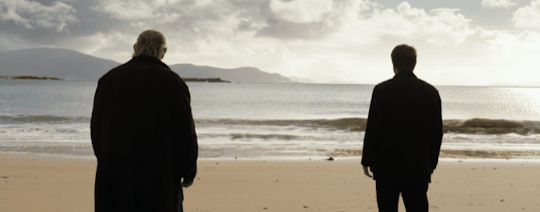
Black Girl (1966) dir. Ousmane Sembène
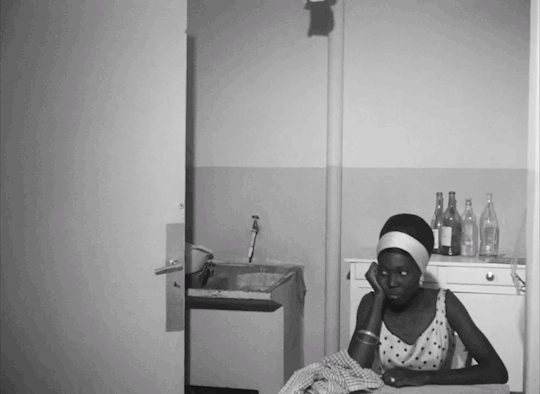
Bringing Out the Dead (1999) dir. Martin Scorsese

Cairo Station (1958) dir. Youssef Chahine
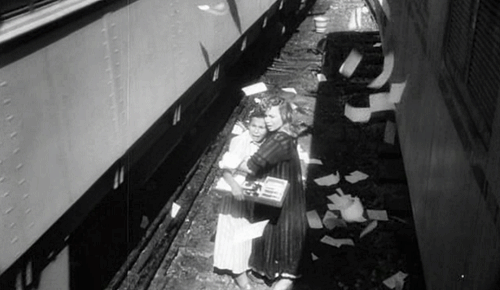
Cemetery Man (1994) dir. Michele Soavi
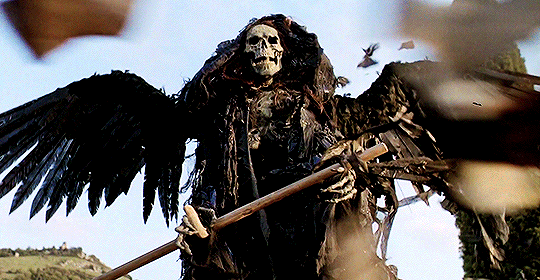
Chicago (2002) dir. Rob Marshall

Crimes of Passion (1984) dir. Ken Russell
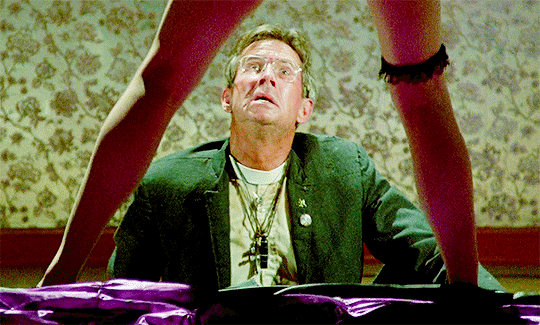
Elvis (2022) dir. Baz Luhrmann

Faust (1926) dir. F.W. Murnau

Female Trouble (1974) dir. John Waters

Fire of Love (2022) dir. Sara Dosa
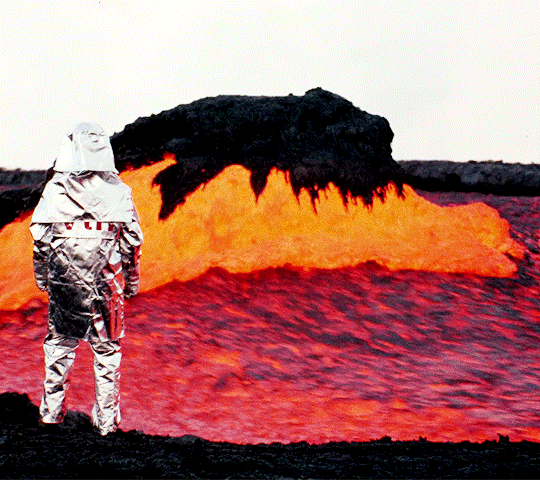
Footprints (on the Moon) (1975) dir. Luigi Bazzoni and Mario Fanelli

Funeral Parade of Roses (1969) dir. Toshio Matsumoto

High and Low (1963) dir. Akira Kurosawa
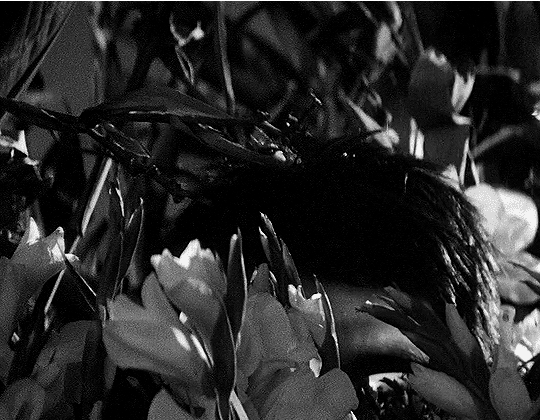
In Search of Darkness: Part III (2022) dir.David A. Weiner
Let the Right One In (2008) dir. Tomas Alfredson
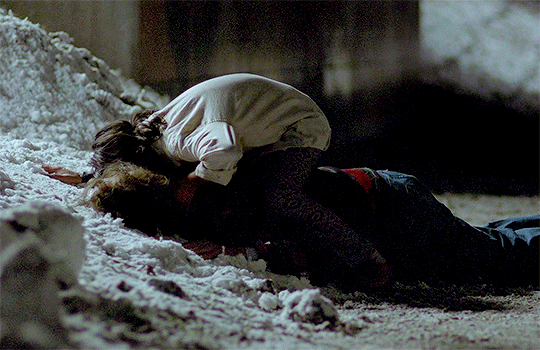
Lingua Franca (2019) dir. Isabel Sandoval
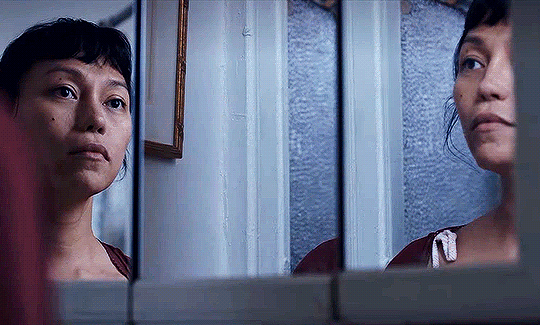
Odd Man Out (1947) dir. Carol Reed
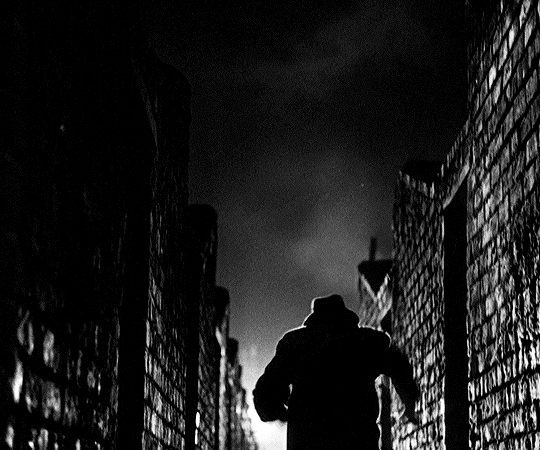
Original Cast Album: Company (1970) dir. D.A. Pennebaker
Paper Moon (1973) dir. Peter Bogdanovich

Pearl (2022) dir. Ti West

Petite Maman (2021) dir. Céline Sciamma

Porco Roso (1992) dir. Hayao Miyazaki

Puss in Boots: The Last Wish (2022) dir. Joel Crawford

Querelle (1982) dir. Rainer Werner Fassbinder

The Silent Partner (1978) dir. Daryl Duke
Slap Shot (1977) dir. George Roy Hill

Southern Comfort (2001) dir. Kate Davis

To Live and Die in L.A. (1985) dir. William Friedkin
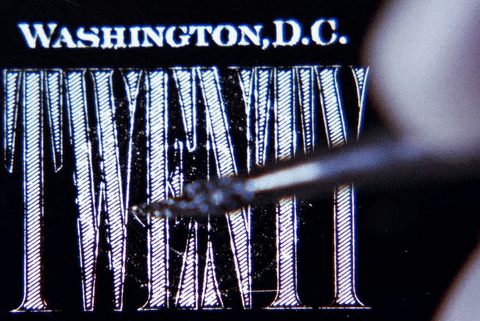
Train to Busan (2016) dir. Yeon Sang-ho

The Umbrellas of Cherbourg (1964) dir. Jacques Demy
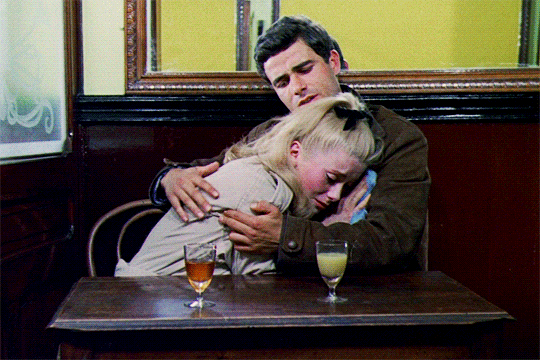
X (2022) dir. Ti West

#movies#2023#1985#2022#1966#1999#1958#1994#2002#1984#1926#1974#1975#1969#1963#2008#2019#1947#1970#1973#2021#1992#1982#1978#1977#2001#2016#1964#year in review
1 note
·
View note
Text
Juillet MMXXIII
Films
Indiana Jones et le Cadran de la destinée (Indiana Jones and the Dial of Destiny) (2023) de James Mangold avec Harrison Ford, Phoebe Waller-Bridge, Mads Mikkelsen, John Rhys-Davies, Thomas Kretschmann et Boyd Holbrook
Un mariage de rêve (Easy Virtue) (2008) de Stephan Elliott avec Jessica Biel, Ben Barnes, Kristin Scott Thomas, Colin Firth, Kimberley Nixon, Katherine Parkinson et Kris Marshall
Douze Heures d'horloge (1959) de Géza von Radványi avec Lino Ventura, Laurent Terzieff, Hannes Messemer, Eva Bartok, Lucien Raimbourg, Suzy Prim, Gert Fröbe et Guy Tréjan
Dies iræ (2003) d'Alexandre Astier avec Tony Saba, Thomas Cousseau, Lionnel Astier, Alexis Hénon, Nicolas Gabion, Franck Pitiot, Jean-Christophe Hembert, Alexandre Astier, Jean-Robert Lombard et Jacques Chambon
La Vérité sur Bébé Donge (1952) d'Henri Decoin avec Jean Gabin, Danielle Darrieux, Gabrielle Dorziat, Claude Génia, Marcel André, Jacques Castelot et Daniel Lecourtois
Sorcerer (1977) de William Friedkin avec Roy Scheider, Bruno Cremer, Francisco Rabal, Amidou, Ramon Bieri, Peter Capell, Karl John et Friedrich von Ledebur
La moutarde me monte au nez (1974) de Claude Zidi avec Pierre Richard, Jane Birkin, Claude Piéplu, Jean Martin, Danielle Minazzoli, Vittorio Caprioli, Julien Guiomar et Henri Guybet
Mission impossible : Dead Reckoning, partie 1 (Mission: Impossible – Dead Reckoning Part One) (2023) de Christopher McQuarrie avec Tom Cruise, Simon Pegg, Rebecca Ferguson, Ving Rhames, Vanessa Kirby, Hayley Atwell et Pom Klementieff
Demain ne meurt jamais (Tomorrow Never Dies) (1997) de Roger Spottiswoode avec Pierce Brosnan, Jonathan Pryce, Michelle Yeoh, Teri Hatcher, Ricky Jay, Götz Otto et Joe Don Baker
Plus dure sera la chute (The Harder They Fall) (1956) de Mark Robson avec Humphrey Bogart, Rod Steiger, Nehemiah Persoff, Mike Lane, Jan Sterling et Max Baer
La Guerre des polices (1979) de Robin Davis avec Claude Brasseur, Claude Rich, Marlène Jobert, Georges Staquet, Jean-François Stévenin, Étienne Chicot, David Jalil, Gérard Desarthe, Jean Rougerie et Jean-Pierre Kalfon
Oppenheimer (2023) de Christopher Nolan avec Cillian Murphy, Emily Blunt, Matt Damon, Robert Downey Jr., Florence Pugh, Josh Hartnett, Casey Affleck, Rami Malek et Kenneth Branagh
L'Odyssée de Pi (Life of Pi) (2012) d'Ang Lee avec Suraj Sharma, Irrfan Khan, Ayush Tandon, Tabu, Adil Hussain, Ayan Khan, Vibish Sivakumar et Rafe Spall
L'Histoire d'Adèle H. (1975) de François Truffaut avec Isabelle Adjani, Bruce Robinson, Sylvia Marriott, Joseph Blatchley, Ivry Gitlis et Ruben Dorey
Meurs un autre jour (Die Another Day) (2002) de Lee Tamahori avec Pierce Brosnan, Halle Berry, Toby Stephens, Rosamund Pike et Rick Yune
La Tulipe noire (1964) de Christian-Jaque avec Alain Delon, Virna Lisi, Dawn Addams, Akim Tamiroff, Adolfo Marsillach, Robert Manuel et Francis Blanche
Séries
Friends Saison 10
Celui qui n'arrivait pas à se confier - Celui qui allait très bien - Celui qui avait décidé de bronzer - Celui qui transformait le gâteau d'anniversaire - Celui qui écrivait une lettre de recommandation - Celui qui a failli avoir la subvention - Celui qui bluffait l'assistante sociale - Celui qui ratait Thanksgiving - Ceux qui rencontraient la mère biologique - Celui qui se faisait coincer - Celui qui trahissait le pacte - Celui qui jouait le rôle du père - Celui qui baragouinait - Celui qui n'aimait pas la maison - Celui qui faisait tout pour retenir Rachel - Celui qui n'aimait pas les adieux - Ceux qui s'en allaient
Inspecteur Barnaby Saison 10
Danse avec la mort - L'Oncle d'Amérique - La Chasse au trésor - Le Blues de l'assassin - Le Flash de la mort - Le Télescope de la mort
Coffre à Catch
#122 : Finlay prend la trique et Ichtou jette l'éponge ! - #123 : Finlay à domicile pour le titre ECW ! - #124 : Les Survivor Series : Des bangers en veux-tu en voilà! - #125 : Beliaroth INFILTRE l'Univers d'Agius! - #126 : MVP et Matt Hardy: de partenaires à adversaires !
Kaamelott Livre I
Le Duel - L'Invasion viking - La Bataille rangée - La Romance de Perceval - Les Funérailles d'Ulfin - Le Chevalier femme - La Carte - Le Repas de famille - Le Répurgateur - Le Labyrinthe - Heat - Les Tartes aux myrtilles - La Table de Breccan - Le Chevalier mystère - Le Fléau de Dieu - Le Garde du corps - Des nouvelles du monde - Codes et Stratégies - Le Maître d’armes - Le Négociateur - Dîner dansant - Le Sixième Sens - Arthur et la Question - Monogame - Les Défis de Merlin - Le Banquet des chefs - Le Signe - En forme de Graal - Le Repos du guerrier - La Dent de requin - La Taxe militaire - La Queue du scorpion - La Potion de fécondité - L’Interprète - Le Sacrifice - À la volette - De retour de Judée - La Botte secrète - L’Assassin de Kaamelott - Le Trois de cœur - Basidiomycètes - L’Imposteur - Compagnons de chambrée - La Grotte de Padraig - Ambidextrie - Raison d’argent - La Romance de Lancelot - Merlin et les Loups - Le Cas Yvain - L’Adoubement - Arthur et les Ténèbres - Le Zoomorphe - La Coccinelle de Madenn - Patience dans la plaine - Le Oud - Le Code de chevalerie - Létal - Azénor - Le Sort de rage - Les Nouveaux Frères - Enluminures - Haunted - Le Secret de Lancelot - Le Serpent géant - Guenièvre et les Oiseaux - Le Dernier Empereur - Perceval relance de quinze - Le Coup d’épée - La Jupe de Calogrenant - Le Prodige du fakir - Un bruit dans la nuit - Feu l’âne de Guethenoc - Goustan le Cruel - Le Chaudron rutilant - La Visite d’Ygerne - Les Clandestins - La Kleptomane - Le Pain - La Mort le Roy Artu - Le Problème du chou - Un roi à la taverne - Les Fesses de Guenièvre - Le Billet doux - Guenièvre et l’Orage - Eunuques et Chauds Lapins - Choc frontal - Le Forage - Le Discobole - L’Expurgation de Merlin - Les Volontaires - Polymorphie - Décibels nocturnes - La Fête de l’hiver - Gladiator - La Blessure mortelle - Le Dragon des tunnels - Retour de campagne - L’Escorte - Tel un chevalier - La Pâte d’amande - La Fureur du dragon - Vox populi - Unagi - L’Éclaireur - Lacrimosa - La Quête des deux renards - Agnus Dei - Le Tourment - La Retraite - La Vraie Nature du Graal
Affaires Sensibles
Le Tour de France fantôme - Tom Simpson : une funeste passion - Lance Armstrong, le héros déchu - 21 juillet 1969 : objectif Lune
Castle Saison 2
Une rose pour l’éternité - Le Contrat - Le Troisième Homme - Le Batteur battu - Journal d'une dominatrice - Messages par balles - La Mort de Nikki - La Malédiction de la momie
Orgueil et Préjugés
Episode 1 - Episode 2 - Episode 3 - Episode 4 - Episode 5 - Episode 6
Raison et Sentiments
Episode 1 - Episode 2 - Episode 3
Spectacles
John Fogerty : Premonition (1997)
Eddy Mitchell au Casino de Paris (1990)
Livres
Pourquoi vous faisez ça ? de Pablo Mira
Gaston , Tome 2 de André Franquin et Jidékeur
Le péplum, un mauvais genre de Claude Aziza
Hero Corp, Tome 2 : Chroniques de Simon Astier, Louis et Stéphane Créty
1 note
·
View note
Text



Zodiac: The Cool Aquarian (1.2, Thames, 1974)
"One 'might', two 'ifs' and a fistful of 'maybes', and you expect me to throw a hundred thousand pounds on the table. God, if I did that we'd be creating a new get-rich-quick industry: asset stripping for beginners. Young girls and millionaires wouldn't be safe on the streets."
"Yes. That's true."
"I tell you one thing, Inspector, every time a hijacker, a kidnapper, or any other thug gets paid off, it makes it easier for the next one."
"It's hard, though, if you're the first to say no."
"Inspector, I love being first. That's the name of my game."
#zodiac#classic tv#thames#1974#roger marshall#jacqueline davis#anouska hempel#anton rodgers#michael gambon#george baker#bill maynard#betty alberge#trevor baxter#alison griffin#deborah fairfax#bruce boa#the relationship between anton and anouska seems to have developed here#into a comfortable familiarity#i wonder how much time is supposed to have passed since the first episode?#this is familiar marshall territory#of unscrupulous businessmen being dastardly#in fact it's quite reminiscent of the earliest surviving public eye episode#nobody kills santa claus#michael gambon is very good as the hard hearted tycoon who might actually be ok#trevor baxter provides comic relief#but the dynamic between the leads is perhaps the most interesting thing#there's very little romantic spark#but they have a great friendly camaraderie which is refreshing in a male female pairing from this era#an improvement on the opener and i'm getting the feel for the series#and so i'm already getting sad that there's only six episodes
5 notes
·
View notes
Text
Characters on the Black superpower breakdown list
Hunk (vld)
Static [Virgil Hawkins]
Black Lightning [Jefferson Peirce]
Kwame (Captain Planet)
Storm [Ororo Monroe]
Strag (Magi-Nation)
Chur (Magi-Nation)
Sistah Spooky (Empowered)
Aqualad [Kaldur'ahm]
Bronze Tiger [Benjamin Turner]
Black Panther [T'Challa]
Bumblebee [Karen Beecher-Duncan]
Nubia (DC comics)
Cyborg [Victor Stone]
Taranee Cook (W.I.T.C.H.)
Spawn [Al Simmons]
Alex Wilder (Runaways)
Blade [Eric Brooks]
Brother Voodoo [Jericho Drumm]
Falcon [Sam Wilson]
Empress [Anita Fite]
Green Lantern [John Stewart]
Lightning [Jennifer Pierce]
Pantha [Rosabelle Mendez]
Tunder [Anissa Pierce]
Vixen [Mari Jiwe McCabe]
Agent 355 (Y: The Last Man)
Prowler [Hobbie Brown]
Prowler [Aaron Davis]
Spiderman [Miles Morales]
Rocket [Raquel Ervin]
Icon [Augustus Freeman]
Cassie (Animorphs)
Anansi the Spider (Static Shock)
She-Bang [Shenice Vale]
Kipo Oak (Kipo and the Age of Wonderbeasts)
Zak Saturday (The Secret Saturdays)
Catwoman [Patience Phillips]
Frozone [Lucius Best]
Erik Killmonger [N'Jadaka]
Black Manta [David Ray]
Holocaust [Leonard Smalls Jr]
Tombstone [Lonnie Thompson Lincoln]
Killer Croc [Waylon Jones]
Deadly Nightshade (Marvel Comics)
Ebon [Ivan Evans]
Baxter Stockman (Teenage Mutant Ninja Turtles)
Monica Rambeau (Marvel Comics)
War Machine [James Rhodes]
Steel [John Henry Irons]
Cloak [Tyrone Johnson]
Queen Bee of Bialya (DC Universe)
Hot Spot/Joto [Isaiah Crockett]
Alan Albright (Ben 10)
Mal Duncan (DC Comics)
XS [Nora West-Allen]
Tempest [Joshua Clay]
Star Boy [Thom Kallor]
Kid Quantum (DC Comic)
Jet (DC Comics)
Jakeem Thunder (DC Comics)
Slipstream (Static Shock)
Boom (Static Shock)
Tamara Lawrence (Static Shock)
Hyde (Static Shock)
Kangor (Static Shock)
Brickhouse (Milestone Media)
Madelyn Spaulding (Static Shock)
Puff (Static Shock)
Onyx (Static Shock)
Replikon (Static Shock)
Osebo (Static Shock)
Mmoboro (Static Shock)
Onini (Static Shock)
Allie Langford/Nails (Static Shock)
Miranda/Mirage (Static Shock)
Adam Evans/Rubber-Band Man (Static Shock)
Garnet (Steven Universe)
Ruby (Steven Universe)
Sapphire (Steven Universe)
Bismuth (Steven Universe)
Doc Saturday (The Secret Saturdays)
Kilik Rung (Soul Eater)
Tsume (Wolf's Rain)
Blue (Wolf's Rain)
Manny Armstrong (Ben 10)
Bow (She-Ra and the Princesses of Power)
Netossa (She-Ra and the Princesses of Power)
Numbuh Five (Codename Kids Next Door)
Cree Lincoln (Codename Kids Next Door)
Paninya (Fullmetal Alchemist)
Jerso (Fullmetal Alchemist)
Scar (Fullmetal Alchemist)
Darui (Naruto)
Killer B (Naruto)
A/3rd Raikage (Naruto)
Karui (Naruto)
Omoi (Naruto)
Muhammad Avdol (Jojo's Bizarre Adventure)
Silver Sentry (TMNT)
April O'Neil (Rise of the TMNT)
Sid Barrett (Soul Eater)
Usopp (One Piece)
Spyke [Evan Daniels]
Talon (Gargoyles)
Winston Zeddmore (Ghostbusters)
Wolf (Kipo and the Age of Wonderbeasts)
Black Racer (DC Comics)
Bloodwynd (DC Comics)
Coldcast (DC Comics)
Gravedigger (DC Comics)
Mister Terrific (DC Comics)
Blue Marvel [Adam Bernard Brashear]
Night Thrasher [Dwayne Taylor]
Jo (Kid Cosmic)
Philly the Kid (Cannon Busters)
S.A.M. (Cannon Busters)
Amalia Sheran Sharm (Wakfu)
Kaz Kaan (Neo Yokio)
Dr. Facilier (The Princess and the Frog)
Raven Baxter (That's So Raven)
John Henry (Folktales)
Darryl (Mercyverse)
Asil the Moor (Mercyverse)
Hork-Bajir (Animorphs)
Ashio (Magi-Nation)
Gogor (Magi-Nation Duel)
Rayje (Magi-Nation Duel)
Strom (Magi-Nation)
Sugar Hill (Sugar Hill 1974)
Thunder (Soul Eater)
Fire (Soul Eater)
Miruko (My Hero Academia)
Rock Lock (My Hero Academia)
Ogun Montogomery (Fire Force)
Manifold [Eden Fesi]
Yoruichi Shihōin (Bleach)
Yasutora Sado/Chad (Bleach)
Gantenbainne Mosqueda (Bleach)
Zommari Rureaux (Bleach)
Shuri (Marvel Comics)
Alya Césaire (Miraculous Ladybug)
Nora Césaire (Miraculous Ladybug)
Max Kanté (Miraculous Ladybug)
Razahir “Raze” Khemse (Underworld)
Jermaine (Xiaolin Showdown)
Piccolo Jr (Dragonball)
Koen West (Cleverman)
Xavin (Runaways)
Goo (Foster's Home for Imaginary Friends)
Wilt (Foster's Home for Imaginary Friends)
Tobias Whale (Black Lightning)
Zak Monday (The Secret Saturdays)
Dion Warren (Raising Dion)
Hex (Ben 10)
Charmcaster (Ben 10)
Annabelle Cane (The Magnus Archives)
Oliver Banks (The Magnus Archives)
Khalil Payne / Painkiller (Black Lightning)
Issa Williams (Black Lightning)
Perenna (Black Lightning)
Giselle Cutter (Black Lightning)
Brandon Marshall/Geo-Force (Black Lightning)
T.C. / Baron/Technocrat (Black Lightning)
Domino (Deadpool 2)
Clayface/Ethan Bennette (The Batman)
Ironheart (Marvel Comics)
Silhouette (Marvel Comics)
Fish Mooney (Gotham)
Valerie Gray (Danny Phantom)
Hack (DC Comics)
Peek-A-Boo (DC Comics)
Madam Slay (Marvel Comics)
Alex (Totally Spies)
Olivia (Pokemon)
Abra Stone (Doctor Sleep)
Tia Dalma [Calypso]
Allura (Voltron)
Raphael (RoTTMNT)
Donatello (RoTTMNT)
Leonardo (RoTTMNT)
Michelangelo (RoTTMNT)
Bebop (TMNT)
Zack Taylor (Power Rangers)
T.J. Johnson (Power Rangers)
Aisha Cambell (Power Rangers)
Jack Landors (Power Rangers)
Tanya Sloan (Power Rangers)
Scott Truman (Power Rangers)
Noah Carver (Power Rangers)
Joel Rawlings (Power Rangers)
Will Aston (Power Rangers)
Katie Walker (Power Rangers)
Ethan James (Power Rangers)
Max Cooper (Power Rangers)
Cestro (Power Rangers)
Damon Henderson (Power Rangers)
Zane (Power Rangers)
A-Squad Green Ranger (power Rangers)
Kevin (Power Rangers)
Shelby Watkins (Power Rangers)
Zayto (Power Rangers)
Hayley Foster (Power Rangers)
Aisha (Winx Club)
Flora (Winx Club)
Catwoman [Selina Kyle]
Rodger (Dino Squad)
Koki (Wild Kratts)
Darla Dudley (DC Comics)
209 characters thus far. If ya fave superpowered negro ain’t here, leave a name, pic, and list of their powers
132 notes
·
View notes
Text
DECADE OF REVOLT
The significance of prisoner protest revolves around an understanding of three central concepts: lumpenproletariat; political prisoner; and politicization.
'Political" Prisoners
By the late 1960s, it was clear that the image of the solitary inmate in rote compliance with the requirements of the prison regime was being replaced by the formation of political allegiances, initially marshalled along racial ethnic lines. The spectre of the penitentiary as a fertile ground for organized protest had placed the prison "at the center of radical politics" (Jacobs, 1976:480) and "in the forefront of the revolutionary movement in America" (Pallas and Barber, 1972:16). Of course the notion of deviance as "political' was not foreign to the sociological lexicon - - recall, for example, Merton's discussion of 'non-conformity' (1957:131-160) and Horowitz and Liebowitz's interpretation of social deviance as 'political marginality' (1967:280-296).
Nevertheless, the claims of black convicts that they were 'political prisoners' (i.e., innocent victims of a corrupt society) - - were regarded by most 'liberal' analysts as emotion-laden metaphors signalling the narrower effects of racial discrimination. The idea that 'common criminals' were 'political prisoners' defied common-sense perception and was particularly hard to accept given that the latter category was traditionally reserved for those who had committed decidedly political acts (e.g., sedition, treason, desertion),or whose actions seemed unarguably altruistic. This conventional view was shaken, however, by remarks such as those made by Andrew Young, the Carter Administration's ambassador to the United Nations:
[in the U.S.], we still have hundreds of people that I would categorize as political prisoners in our prisons. Maybe even thousands, depending on how you categorize them (Sobel, 1978:25).
Young's statement, which resulted in an official reprimand, echoed both the strident accusations of black prisoners appearing in the popular media (e.g., Browning, 1972; Pell, 1972) and the more dispassionate pronouncements of social scientists, who now saw imprisonment trends in unmistakably political terms. Thus, Erik Olin Wright concluded that all prisoners are 'political prisoners' because:
The particular forms that punishment takes and the severity of punishment accorded specific offenses is a matter of political policy and varies considerably among political systems .... punishment, as a deterrent to crime, is an essential tool of social control by the political system (1973:24).
Such sociologically couched abstractions acquired a specific gravity in the blunt summations of front-line resisters:
Sisters and brothers axe becoming cognizant of the fact that jails and prisons are concentration camps for the poor (Davis, 1971:25).
Prisons should be viewed as no more than the ruling class's last line of defense against the industrial reserve army (Huston, 1973:32).
These perceptions were reinforced by the disproportionate imprisonment of black males in the U.S. (Christianson, 1981), by official atrocities in response to protest incidents as at Attica (Martinson, 1972), and by political trials such as the Chicago Seven and the San Quentin Six (Wald, 1976), all of which underscored the repressive character of American prisons and further exposedthe conflictual nature of 'crime'.
While much of this ferment took place in U.S. prisons, the aura of dissent permeated Canadian institutions as well, peaking in 1975-76 with major incidents involving hostage-takings and other violent disturbances, and prompting an emergency inquiry into the Canadian penitentiary system (MacGuigan, 1977). In the less turbulent setting of Canadian society, most Canadian penologists tended to regard these prison disturbances as stemming from 'managerial' problems with difficult inmates (Desroches, 1974), as the consequence of inept prison administration (Douglas et al., 1980), as a function of the tense prison 'atmosphere' (Jayewardene and Jayasuriya, 1981) or of the constraints of the 'inmate code' (Lowman, 1986), or as an outcome of contradictions between the control and rehabilitative functions of prisons (MacLean, 1983). Some rudimentary political interpretations were formulated (Culhane, 1985), with Gosselin's indictment of the Canadian prison system finding strong resonances with the political critiques circulated by the American Black Power movement:
...the struggle against the penitentiar yis above all the struggle against the social system that creates such an institution. Viewed from that perspective, all prisoners are political prisoners (1982:176)
- R.S. Ratner, University of British Columbia, and Barry Cartwright, “Politicized Prisoners: From Class Warriors to Faded Rhetoric.” The Journal of Human Justice, Vol 2, No. 1, Autumn, 1990. p. 77-78.
#political prisoners#prisoner revolt#prisoner resistance#prisoners' movement#prisoner protest#canadian prisons#prison riots#racism in prison#penology#criminology#critical criminology#history of crime and punishment in canada#crime and punishment in canada#academic research#research quote#r. s. ratner#repression of dissidents
12 notes
·
View notes
Text
¡LAS 10 MEJORES PELÍCULAS DE LA HISTORIA! (según usuarios de IMDb)
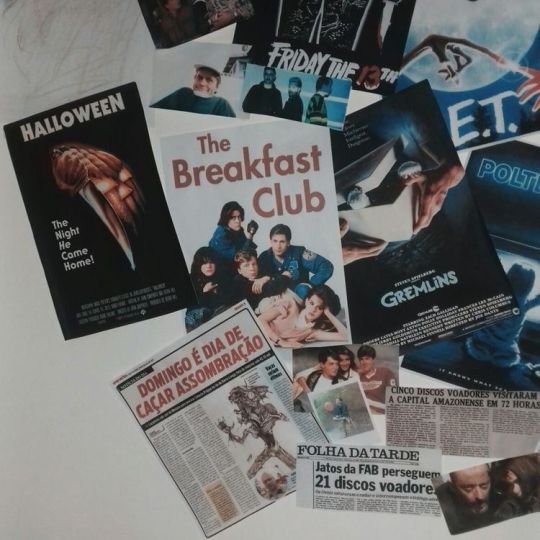
10 - El señor de los anillos: La comunidad del anillo (2001)
Director: Peter Jackson.
Reparto: Elijah Wood, Viggo Mortensen, Sean Astin, Orlando Bloom, Ian McKellen, Billy Boyd, Dominic Monaghan, Sean Bean, Cate Blanchett, Liv Tyler, Andy Serkis & Hugo Weaving.
9- El bueno, el feo y el malo (1966)
Director: Sergio Leone.
Reparto: Clint Eastwood, Eli Wallach, Lee Van Cleef, Rada Rassimov, Aldo Giuffrè, Mario Brega, Luigi Pistilli, Antonio Casale, John Bartha, Antonio Casas, Al Mulock & Aldo Sambrell.
8- Pulp Fiction (1994)
Director: Quentin Tarantino.
Reparto: Quentin Tarantino, John Travolta, Samuel L. Jackson, Uma Thurman, Bruce Willis, Tim Roth, Harvey Keitel, Amanda Plummer, Christopher Walken, Eric Stoltz, Ving Rhames & Maria de Medeiros.
7- El señor de los anillos: El retorno del rey (2003)
Director: Peter Jackson.
Reparto: Elijah Wood, Viggo Mortensen, Andy Serkis, Ian McKellen, Sean Astin, Karl Urban, Orlando Bloom, Liv Tyler, Miranda Otto, John Noble, Cate Blanchett & John Rhys-Davies.
6- La lista de Schindler (1993)
Director: Steven Spielberg.
Reparto: Liam Neeson, Ralph Fiennes, Ben Kingsley, Embeth Davidtz, Emilie Schindler, Caroline Goodall, Jonathan Sagall, Oliwia Dabrowska, Beatrice Macola, Anna Mucha, Mark Ivanir & Malgorzata Gebel.
5- 12 hombres sin piedad (1957)
Director: Sidney Lumet.
Reparto: Henry Fonda, Lee J. Cobb, Ed Begley, Joseph Sweeney, Jack Kiugman, Martin Balsam, Jack Lemmon, Jack Warden, E. G. Marshall, George C. Scott, John Fiedler & John Savoca.
4- El caballero oscuro (2008)
Director: Christopher Nolan.
Reparto: Chritian Bale, Heath Ledger, Gary Oldman, Michael Caine, Aaron Eckhart, Morgan Freeman, Tom Hardy, Anne Hathaway, Cillian Murphy, Maggie Gyllenhaal, Joseph Gordon-Levitt & Néstor Gastón Carbonell.
3- El padrino. Parte III (1974)
Director: Francis Ford Coppola.
Reparto: Al Pacino, Sofia Coppola, Andy García, Diane Keaton, Talia Shire, Eli Wallach, Bridget Fonda, Robert De Niro, George Hamilton, Joe Mantegna, Franc D'Ambrosio & Marlon Brando.
2- El padrino (1972)
Director: Francis Lord Coppola.
Reparto: Al Pacino, Marlon Brando, Robert De Niro, Diane Keaton, James Caan, Talia Shire, John Cazale, Richard S. Castellano, Al Lettieri, Tere Livrano, Al Martino & Gianni Russo.
1- Cadena Perpetua (1994)
Director: Frank Darabont.
Reparto: Morgan Freeman, Tim Robbins, Bob Gunton, Clancy Brown, William Sadler, Gil Bellows, James Whitmore, Mark Rolston, Alfonso Freeman, Jeffrey DeMunn, Renee Blaine & Neil Giuntoli.
3 notes
·
View notes
Text
Las 236 películas que he visto en 2021 (parte 1)
En negrita la que os recomiendo:
1.- Las manos de Orlac (Robert Wiene, 1925)
2.- Just Imagine (David Butler, 1930)
3.- Los ángeles del infierno (Howard Hughes, 1930)
4.- El secreto de vivir (Frank Capra, 1936)
5.- El ídolo de Nueva York (Rowland V Lee, 1937)
6.- The mysterious Mr Davis (Claude Autant-Lara, 1939)
7.- El bazar de las sorpresas (Ernst Lubitsch, 1940)
8.- Juan Nadie (Frank Capra, 1941)
9.- La mujer pantera (Jacques Torneur, 1942)
10.- El forajido (Howard Hughes, 1943)
11.- Alma en suplicio (Michael Curtiz, 1945)
12.- El socio (Roberto Gavaldon, 1946)
13.- Eugenia Grandet (Mario Soldati, 1946)
14.- Rio Rojo (Howard Hawks, 1948)
15.- El molino del Po (Alberto Lattuada, 1949)
16.- Rashomon (Akira Kurosawa, 1950)
17.- Muerte de un viajante (László Benedek, 1951).
18.- On the waterfront (Elia Kazan, 1954)
19.- Inside Detroit (Fred F Sears, 1956)
20.- Jubal (Delmer Daves, 1956)
21.- La rebeldía de la Sra. Stover (Raoul Walsh, 1956)
22.- Crimen, S.A. (Sydney Salkow, 1957)
23.- Mas fuerte que la vida (Martin Ritt, 1957)
24.- Portland Exposé (Harold D Schuster, 1957)
25.- El ataque de la mujer de 50 pies (Nathan Juran, 1958).
26.- Como atrapar un marido (George Marshall, 1959)
27.- Cover Girl Killer (Terry Bishop, 1959)
28.- Horror en el Museo Negro (Arthur Crabtree, 1959).
30.- La indómita y el millonario (Richard Quine, 1959)
31.- Nunca robes cosas pequeñas (Charles Lederer, 1959)
32.- The big operator (Charles F Haas, 1959)
33.- The angry silence (Guy Green, 1960)
34.- Pijama para dos (Delbert Mann, 1961)
35.- El confidente (Jean-Pierre Melville, 1962)
36.- Bitter harvest (Peter Graham Scott, 1963)
37.- La muchacha que sabia demasiado (Mario Bava, 1963)
38.- El hombre de Rio (Philippe de Brocca, 1964)
39.- El coleccionista (William Wyler, 1965).
40.- La llamada del espacio (John Gilling, 1965)
41.- SOS El mundo en peligro (Terence Fisher, 1966)
42.- El gran robo (Peter Yates, 1967)
43.- Viy (Konstantin Yershov y Georgi Kropachyov, 1967)
44.- Joe el implacable (Sergio Corbucci, 1968)
45.- The touchables (Peter Freeman, 1968)
46.- Moon zero two (Roy Ward Baker, 1969)
47.- Odio en las entrañas (Martin Ritt, 1969)
48.- El conformista (Bernardo Bertolucci, 1970).
49.- El pájaro de las plumas de cristal (Dario Argento, 1970).
50.- Gas-s-s-s (Roger Corman, 1970)
51.- Terror en Dunwich (Daniel Haller, 1970)
52.- ¿Qué habéis hecho con Solange? (Massimo Dallamano, 1972)
53.- El caso Mattei (Francesco Rosi, 1972)
54.- Cómo destruir al más famoso agente secreto del mundo (Philippe de Brocca, 1973)
55.- El fin de Sheila (Herbert Ross, 1973)
56.- Salvad al tigre (John G. Avildsen, 1973)
57.- Sillas de montar calientes (Mel Brooks. 1974).
58.- Jeanne Dielman, 23, quai du commerce, 1080 Bruxelles (Chantal Akerman, 1975)
59.- Novecento (Bernardo Bertolucci, 1976)
60.- El hombre de mármol (Andrej Wajda, 1977)
61.- Blue Collar (Paul Schrader, 1978)
62.- FIST, símbolo de fuerza (Norman Jewison, 1978)
63.- The Betsy (Daniel Petrie, 1978)
64.- Dracula (John Badham, 1979)
65.- El socio (Rene Gainville, 1979).
66.- La hipótesis de un cuadro robado (Raul Ruiz, 1979)
67.- El hombre de hierro (Andrej Wajda, 1977)
68.- Después de... primera parte: Atado y bien atado (Cecilia y Jose Juan Batolome, 1981)
69.- En busca del fuego (Jean Jacques Annaud, 1981)
70.- Función de noche (Josefina Molina, 1981)
71.- Turno de noche (Ron Howard, 1982)
72.- Despues de... segunda parte: No se os puede dejar solos (Cecilia y Jose Juan Bartolome, 1983)
73.- Risky Business (Paul Blickman, 1983).
74.- El jinete pálido (Clint Eastwood, 1985)
75.- Mad Max: Mas allá de la cúpula del trueno (George Miller, 1985)
76.- La matanza de Texas 2 (Tobe Hooper, 1986)
77.- Todo en un día (John Hughes, 1986)
78.- Atracción Fatal (Adrian Lyne, 1987)
79.- Business As Usual (Lezli-An Barrett, 1987)
80.- Marusa no onna (Juzo Itami, 1987)
81.- Los fantasmas atacan al jefe (Richard Donner, 1988)
82.- Última salida Brooklyn (Uli Edel, 1989).
83.- Bailando con lobos (Kevin Costner, 1990)
84.- El Exorcista III (William Peter Blatty, 1990).
85.- Los ojos del diablo (Dario Argento y George A Romero, 1990).
86.- Los chicos del barrio (John Singleton, 1991)
87.- Manto Negro (Bruce Beresford, 1991)
88.- Candyman (Bernard Rose, 1992).
89.- Daens (Stijn Coninx, 1992).
90.- Sonambulos (Mick Garris, 1992)
91.- Dave, presidente por un día (Ivan Reitman, 1993)
92.- El informe Pelicano (Alan J Pakula, 1993)
93.- La suplente (Tom Holland, 1993)
94.- La tapadera (Sydney Pollack, 1993)
95.- Lloviendo piedras (Ken Loach, 1993).
96.- Tombstone (George P Cosmatos, 1993)
97.- Acoso (Barry Levinson, 1994)
98.- Días Extraños (Kathryn Bigelow, 1995)
99.- Friday (F Gary Gray, 1995).
100.- Sabrina (Sydney Pollack, 1995)
101.- Safe (Todd Haynes, 1995)
102.- American Jobs (Chris Smith, 1996)
103.- La mujer del super (Jūzō Itami, 1996)
104.- En compañía de hombres (Neil LaBute, 1997).
105.- Hormigaz (Eric Darnell y Tim Johnson, 1998)
106.- Ronin (John Frankenheimer, 1998)
107.- Rounders (John Dahl, 1998)
108.- Salvar al soldado Ryan, (Steven Spielberg, 1998).
109.- Star Trek: Insurrección (Jonathan Frakes, 1998)
110.- Un romance muy peligroso (Steven Soderbergh, 1998)
111.- Galaxy Quest (Dean Parisot, 1999)
112.- La ducha (Zhang Yang, 1999)
113.- La humanidad (Bruno Dumont, 1999)
114.- Lista de espera (Juan Carlos Taibo, 1999)
115.- October Sky (Joe Johnston, 1999)
116.- Amor con preaviso (Marc Lawrence, 2002)
117.- En América (Jim Sheridan, 2002)
118.- Mr Deeds (Steven Brills, 2002).
119.- Oligarkh (Pavel Lounguine, 2002)
120.- Sweet Home Alabama (Andy Tennant, 2002)
121.- El jurado (Gary Fleder, 2003)
122.- Kitchen Stories (Bent Hamer, 2003)
123.- Code 46 (Michael Winterbottom, 2003)
124.- El nuevo mundo (Terrence Malick, 2005)
125.- ¡Marchando! (Rob McKittrick, 2005)
125.- 16 calles (Richard Donner, 2006)
126.- Apocalypto (Mel Gibson, 2006).
127.- Bosque de sombras (Koldo Serra, 2006)
128.- Empleado del mes (Greg Coolidge, 2006)
129.- Mas extraño que la ficción (Marc Forster, 2006)
130.- Un franco 14 pesetas (Carlos Iglesias, 2006)
131.- Bee Movie (Simon J. Smith y Steve Hickner, 2007)
132.- Import/Export (Ulrich Seidl, 2007)
133.- Los extraños (Bryan Bertino, 2008)
134.- Sleep dealer (Alex Rivera, 2008)
135.- Avatar (James Cameron, 2009)
136.- Arrástrame al infierno (Sam Raimi, 2009)
137.- La proposición (Anne Fletcher, 2009)
138.- Sin nombre (Cary Joji Fukunaga, 2009)
139.- El libro de Eli (The Hughes Brothers, 2010)
140.- Kill List (Ben Wheatley, 2011)
141.- Una vida mejor (Chris Weitz, 2011)
142.- Warrior (Gavin O’Connor, 2011)
143.- Jack Reacher (Christopher McQuarrie, 2012)
144.- Park Avenue. Money, Power and the American Dream (Alex Gibney, 2012)
145.- Secuestro (Tobias Lindholm, 2012)
146.- A field in England (Ben Wheatley, 2013)
147.- Coherence (James Ward Byrkit, 2013)
148.- El desconocido del lago (Alain Guiraudie, 2013)
149.- La gran seducción (Don McKellar, 2013)
150.- The Host (Andrew Niccol, 2013)
151.- Divergent (Neil Burger, 2014)
152.- El dador de recuerdos (Phillip Noyce, 2014)
153.- Night Moves (Kelly Reichardt, 2014)
154.- Predestination (Michael y Peter Spierig, 2014)
155.- Pride (Matthew Warchus, 2014)
156.- The Big Men (Rachel Boynton, 2014)
157.- Una chica vuelve a casa sola de noche (Ana Lily Amirpour, 2014)
158.- Blackhat, amenaza en la red (Michael Mann, 2015)
159.- Brooklyn (John Crowley, 2015)
160.- El corredor del laberinto: Las pruebas (Wes Ball, 2015)
161.- Evolution (Lucile Hadžihalilović, 2015)
162.- Insurgent (Robert Schwentke, 2015)
163.- Steve Jobs (Danny Boyle, 2015).
164.- Tomorrowland (Brad Bird, 2015)
165.- Allegiant (Robert Schwentke, 2016)
166.- Crudo (Julia Darconau, 2016)
167.- Jackie (Pablo Larrain, 2016)
168.- Jack Reacher: Nunca vuelvas atrás (Edward Zwick, 2016)
3 notes
·
View notes
Photo








Ja’Net Dubois Dies at 74 From Natural Causes.
This is her appreciation post, details of her life and maybe something you didn’t know about her. Enjoy! Rest in paradise Queen.
Jeannette Dubois known professionally as Ja'Net DuBois for her portrayal of Willona Woods, the neighborhood gossip maven and a friend of the Evans family on the sitcom Good Times, which originally aired from 1974 to 1979. DuBois additionally co–wrote and sang the theme song "Movin' on Up" for The Jeffersons, which originally aired from 1975 until 1985. Ja’Net also played the grandmother on the popular hit show The Wayans Bro. She also did voice over on The PJs as “Mrs. Florence Avery” and so many other shows and movies like “ I'm Gonna Git You Sucka ”.
She won and image award for Good Times as well as two Primetime Emmys for voice over for The PJs. Plus she was nominated for and NAACP Image Award for Touch By And Angel. In 1995, DuBois won a CableACE award for Best Supporting Actress for her role in the Lifetime movie “Other Women's Children”. In 2000, DuBois served as Grand Marshal for the North Amityville Community Parade and Festival Day in Amityville, New York.
Ja’Net had 4 children one who passed in 1987 due to cancer, she also was married to Sajit Gupta. She was romantically linked with Actor Brock Peters famously known from the movie To Kill A Mockingbird. DuBois recorded a album Again, Ja'Net DuBois, on her Peanuts and Caviar label, in 1983. DuBois appeared in former Good Times co-star Janet Jackson's 1987 "Control" music video as her mother. In 1992, she co-starred with Clifton Davis in “And I Still Rise”, a play written and directed by Maya Angelou. During the 1980s, DuBois operated the Ja'net DuBois Academy of Theater Arts and Sciences, a performing-arts school for teenagers in Long Island, New York. In 1992, DuBois, Danny Glover and Ayuko Babu co-founded the Pan African Film & Arts Festival in Los Angeles. DuBois died on February 17, 2020, of natural causes at her Glendale, California, home.
Our condolences goes out to her family, prayers for fans, friends and family she will truly be missed.
#Janet Dubois#janet jackson#good times#rest in peace#the jeffersons#the pjs#classic black beauties#vintage black glamour
447 notes
·
View notes
Photo

Lee Konitz, jazz alto saxophonist who was a founding influence on the ‘cool school’ of the 1950s died aged 92
The music critic Gary Giddins once likened the alto saxophone playing of Lee Konitz, who has died aged 92 from complications of Covid-19, to the sound of someone “thinking out loud”. In the hothouse of an impulsive, spontaneous music, Konitz sounded like a jazz player from a different habitat entirely – a man immersed in contemplation more than impassioned tumult, a patient explorer of fine-tuned nuances.
Konitz played with a delicate intelligence and meticulous attention to detail, his phrasing impassively steady in its dynamics but bewitching in line. Yet he relished the risks of improvising. He loved long, curling melodies that kept their ultimate destinations hidden, he had a pure tone that eschewed dramatic embellishments, and he seemed to have all the time in the world. “Lee really likes playing with no music there at all,” the trumpeter Kenny Wheeler once told me. “He’ll say ‘You start this tune’ and you’ll say ‘What tune?’ and he’ll say ‘I don’t care, just start.’”
Born in Chicago, the youngest of three sons of immigrant parents – an Austrian father, who ran a laundry business, and a Russian mother, who encouraged his musical interests – Konitz became a founding influence on the 1950s “cool school”, which was, in part, an attempt to get out of the way of the almost unavoidable dominance of Charlie Parker on post-1940s jazz. For all his technical brilliance, Parker was a raw, earthy and impassioned player, and rarely far from the blues. As a child, Konitz studied the clarinet with a member of Chicago Symphony Orchestra and he had a classical player’s silvery purity of tone; he avoided both heart-on-sleeve vibrato and the staccato accents characterising bebop.
However, Konitz and Parker had a mutual admiration for the saxophone sound of Lester Young – much accelerated but still audible in Parker’s phrasing, tonally recognisable in Konitz’s poignant, stately and rather melancholy sound. Konitz switched from clarinet to saxophone in 1942, initially adopting the tenor instrument. He began playing professionally, and encountered Lennie Tristano, the blind, autocratic, musically visionary Chicago pianist who was probably the biggest single influence on the cool movement. Tristano valued an almost mathematically pristine melodic inventiveness over emotional colouration in music, and was obsessive in its pursuit. “He felt and communicated that music was a serious matter,” Konitz said. “It wasn’t a game, or a means of making a living, it was a life force.”
Tristano came close to anticipating free improvisation more than a decade before the notion took wider hold, and his impatience with the dictatorship of popular songs and their inexorable chord patterns – then the underpinnings of virtually all jazz – affected all his disciples. Konitz declared much later that a self-contained, standalone improvised solo with its own inner logic, rather than a string of variations on chords, was always his objective. His pursuit of this dream put pressures on his career that many musicians with less exacting standards were able to avoid.
Konitz switched from tenor to alto saxophone in the 1940s. He worked with the clarinettist Jerry Wald, and by 20 he was in Claude Thornhill’s dance band. This subtle outfit was widely admired for its slow-moving, atmospheric “clouds of sound” arrangements, and its use of what jazz hardliners sometimes dismissed as “front-parlour instruments” – bassoons, French horns, bass clarinets and flutes.
Regular Thornhill arrangers included the saxophonist Gerry Mulligan and the classically influenced pianist Gil Evans. Miles Davis was also drawn into an experimental composing circle that regularly met in Evans’s New York apartment. The result was a series of Thornhill-like pieces arranged for a nine-piece band showcasing Davis’s fragile-sounding trumpet. The 1949 and 1950 sessions became immortalised as the Birth of the Cool recordings, though they then made little impact. Davis was the figurehead, but the playing was ensemble-based and Konitz’s plaintive, breathy alto saxophone already stood out, particularly on such drifting tone-poems as Moon Dreams.
Konitz maintained the relationship with Tristano until 1951, before going his own way with the trombonist Tyree Glenn, and then with the popular, advanced-swing Stan Kenton orchestra. Konitz’s delicacy inevitably toughened in the tumult of the Kenton sound, and the orchestra’s power jolted him out of Tristano’s favourite long, pale, minimally inflected lines into more fragmented, bop-like figures. But the saxophonist really preferred small-group improvisation. He began to lead his own bands, frequently with the pianist Ronnie Ball and the bassist Peter Ind, and sometimes with the guitarist Billy Bauer and the brilliant West Coast tenor saxophonist Warne Marsh.
In 1961 Konitz recorded the album Motion with John Coltrane’s drummer Elvin Jones and the bassist Sonny Dallas. Jones’s intensity and Konitz’s whimsical delicacy unexpectedly turned out to be a perfect match. Konitz also struck up the first of what were to be many significant European connections, touring the continent with the Austrian saxophonist Hans Koller and the Swedish saxophone player Lars Gullin. He drifted between playing and teaching when his studious avoidance of the musically obvious reduced his bookings, but he resumed working with Tristano and Marsh for some live dates in 1964, and played with the equally dedicated and serious Jim Hall, the thinking fan’s guitarist.
Konitz loved the duo format’s opportunities for intimate improvised conversation. Indifferent to commercial niceties, he delivered five versions of Alone Together on the 1967 album The Lee Konitz Duets, first exploring it unaccompanied and then with a variety of other halves including the vibraphonist Karl Berger. The saxophonist Joe Henderson and the trombonist Marshall Brown also found much common ground with Konitz in this setting. Konitz developed the idea on 1970s recordings with the pianist-bassist Red Mitchell and the pianist Hal Galper – fascinating exercises in linear melodic suppleness with the gently unobtrusive Galper; more harmonically taxing and wider-ranging sax adventures against Mitchell’s unbending chord frameworks.
Despite his interest in new departures, Konitz never entirely embraced the experimental avant garde, or rejected the lyrical possibilities of conventional tonality. But he became interested in the music of the pianist Paul Bley and his wife, the composer Carla Bley, and in 1987 participated in surprising experiments in totally free and non jazz-based improvisation with the British guitarist Derek Bailey and others.
Konitz also taught extensively – face to face, and via posted tapes to students around the world. Teaching was his refuge, and he often apparently preferred it to performance. In 1974 Konitz, working with Mitchell and the alto saxophonist Jackie McLean in Denmark, recorded a brilliant standards album, Jazz à Juan, with the pianist Martial Solal, the bassist Niels-Henning Orsted Pedersen and the drummer Daniel Humair. That year, too, Konitz released the captivating, unaccompanied Lone-Lee with its spare and logical improvising, and a fitfully free-funky exploration with Davis’s bass-drums team of Dave Holland and Jack DeJohnette.
In the 1980s, Konitz worked extensively with Solal and the pianist Michel Petrucciani, and made a fascinating album with a Swedish octet led by the pianist Lars Sjösten – in memory of the compositions of Gullin, some of which had originally been dedicated to Konitz from their collaborations in the 1950s. With the pianist Harold Danko, Konitz produced music of remarkable freshness, including the open, unpremeditated Wild As Springtime recorded in Glasgow in 1984. Sometimes performing as a duo, sometimes within quartets and quintets, the Konitz/Danko pairing was to become one of the most productive of Konitz’s musical relationships.
Still tirelessly revealing how much spontaneous material could be spun from the same tunes – Alone Together and George Russell’s Ezz-thetic were among his favourites – by the end of the 1980s Konitz was also broadening his options through the use of the soprano saxophone. His importance to European fans was confirmed in 1992 when he received the Danish Jazzpar prize. He spent the 1990s moving between conventional jazz, open-improvisation and cross-genre explorations, sometimes with chamber groups, string ensembles and full classical orchestras.
On a fine session in 1992 with players including the pianist Kenny Barron, Konitz confirmed how gracefully shapely yet completely free from romantic excess he could be on standards material. He worked with such comparably improv-devoted perfectionists as Paul Motian, Steve Swallow, John Abercrombie, Marc Johnson and Joey Baron late in that decade. In 2000 he showed how open to wider persuasions he remained when he joined the Axis String Quartet on a repertoire devoted to 20th-century French composers including Erik Satie, Claude Debussy and Maurice Ravel.
In 2002 Konitz headlined the London jazz festival, opening the show by inviting the audience to collectively hum a single note while he blew five absorbing minutes of typically airy, variously reluctant and impetuous alto sax variations over it. The early 21st century also heralded a prolific sequence of recordings – including Live at Birdland with the pianist Brad Mehldau and some structurally intricate genre-bending with the saxophonist Ohad Talmor’s unorthodox lineups.
Pianist Richie Beirach’s duet with Konitz - untypically playing the soprano instrument - on the impromptu Universal Lament was a casually exquisite highlight of Knowing Lee (2011), an album that also compellingly contrasted Konitz’s gauzy sax sound with Dave Liebman’s grittier one.
Konitz was co-founder of the leaderless quartet Enfants Terribles (with Baron, the guitarist Bill Frisell and the bassist Gary Peacock) and recorded the standards-morphing album Live at the Blue Note (2012), which included a mischievous fusion of Cole Porter’s What Is This Thing Called Love? and Subconscious-Lee, the famous Konitz original he had composed for the same chord sequence. First Meeting: Live in London Vol 1 (2013) captured Konitz’s improv set in 2010 with the pianist Dan Tepfer, bassist Michael Janisch and drummer Jeff Williams, and at 2015’s Cheltenham Jazz Festival, the old master both played and softly sang in company with an empathic younger pioneer, the trumpeter Dave Douglas. Late that year, the 88-year-old scattered some characteristically pungent sax propositions and a few quirky scat vocals into the path of Barron’s trio on Frescalalto (2017).
Cologne’s accomplished WDR Big Band also invited Konitz (a resident in the German city for some years) to record new arrangements of his and Tristano’s music, and in 2018 his performance with the Brandenburg State Orchestra of Prisma, Gunter Buhles’s concerto for alto saxophone and full orchestra, was released. In senior years as in youth, Konitz kept on confirming Wheeler’s view that he was never happier than when he didn’t know what was coming next.
Konitz was married twice; he is survived by two sons, Josh and Paul, and three daughters, Rebecca, Stephanie and Karen, three grandchildren and a great-grandchild.
• Lee Konitz, musician, born 13 October 1927; died 15 April 2020
Daily inspiration. Discover more photos at http://justforbooks.tumblr.com
13 notes
·
View notes
Photo
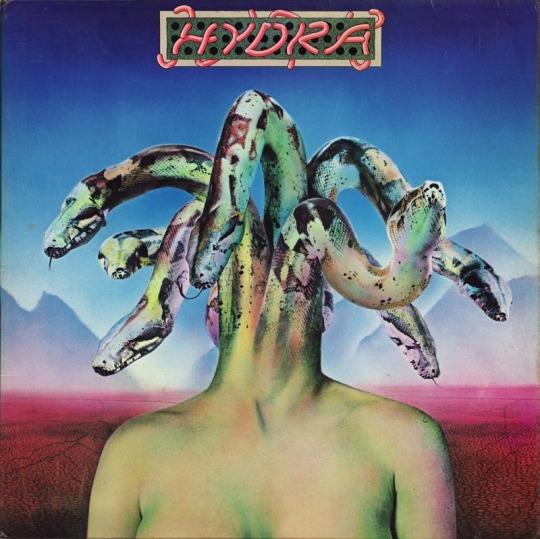

Hydra - Selftitled (UK Album 1974)
Based in the southern states of America, hard rock band Hydra formed in the early 70s around a line-up of Wayne Bruce (vocals, guitar), Spencer Kirkpatrick (guitar), Orville Davis (bass) and Steve Pace (drums). Signed to the Allman Brothers and Marshall Tucker Band’s record label, Capricorn Records, they made their debut in 1974 with a self-titled collection that drew heavily on Lynyrd Skynyrd’s southern boogie tradition, but also added elaborate pop hooks and disciplined rhythmic codas. Songs such as ‘Glitter Queen’ won them a fervent fanbase, though the subsequent Land Of Money, a more abrasive collection, was less successful. By the advent of Rock The World Davis had departed to join Rex and the resultant instability stalled the group’s progress.
Hydra is an American Southern rock band founded in the late 1960s by Spencer Kirkpatrick (guitar), Wayne Bruce (vocals and guitar), and Steve Pace (drums). In 1977, it became a three-piece band (with Wayne Bruce now on bass) and the band broke up later that year. It released three albums, Hydra (1974), Land of Money (1975) and Rock The World (1977). In 2005, the band reunited for two shows (with Vickery on bass). A live album, Hydra: Live After All These Years was released.
Pace and Kirkpatrick first played together in 1968 in the band Strange Brew. Wayne Bruce was playing with the band Nickelodian and accepted the offer to join Pace and Kirkpatrick in the short-lived Noah Mayflower. These three remained together in the band Osmosis until 1969 when, after enlisting a succession of bassists, Hydra finally emerged with the inclusion of Trip Burgess in 1970, and later Orville Davis in 1971. Orville remained with Hydra on their first two LP's before leaving the group to join the hard rock outfit Rex and then briefly Starz. Hydra's reputation as a solid live act in the Atlanta, Georgia area began to spread and the band expanded their territory.They began supporting major internationally known acts in concert.They have been referred to[by whom?] as the first heavy southern rock band.
The band signed a recording contract with Capricorn Records in 1973 and released a self-titled album Hydra in 1974. In 1975, Land of Money followed. The producer Dan Turbeville used a horn section (without the band's knowledge) on the first album and musicians like Chuck Leavell (Allman Brothers band, The Rolling Stones, and Eric Clapton) (piano and keyboards) and Randall Bramblett, who later founded his own Randall Bramblett Band, on the second.
In 1977, as a three-piece band (with Wayne Bruce now on bass), Hydra released Rock The World. Some reviewers[who?], including Edgar Brimer, their road manager, consider this to be their best record. By the end of 1977, the band broke up and reformed only occasionally thereafter, except for a series of shows in 1997, first with Jimmy Cobb and later with Tommy Vickery on bass, replacing Davis.
Hydra was one of those 70’s Southern rock bands that didn’t quite reach the commercial success they deserved. Hydra released three excellent albums between 1974 and 1977 before becoming frustrated with the growth of their success along with some management issues. They broke up in 1977 and have since only played handful of live shows in few different occasions.
Hydra was started in Atlanta, Georgia around 1968 by Steve Pace (drums) and Spencer Kirkpatrick (guitar) and Wayne Bruce (vocals/guitar) under the name Noah Mayflower. They briefly changed their name to Osmosis before taking the name Hydra in 1971 and added Orville Davis to bass.
After building a reputation as killer live band by supporting various major bands like Lynyrd Skynyrd, The Allman Brothers Band and ZZ Top, Phil Walden signed them to his Capricorn Record label in 1973. Hydra´s self-titled debut album came out in 1974.
After year of touring and writing new songs on the road, their sophomore effort, Land Of Money, was released in 1975 and bassist Orville Davis left the band soon after to launch his own career as a country singer.
In 1976 Hydra signed a deal with Polydor Records and Rock the World came out in 1977 featuring three piece band with Wayne Bruce switching from guitar to bass, but by the end of 1977 Hydra broke up only to make a brief come back in 1997 with handful of live shows.
In 2005 Hydra played two more live dates, which were recorded into a live album called Hydra: Live After All These Years. The band haven´t completely shut out the option of recording new music under Hydra name in the future.
01.Glitter Queen - 4:02
02.Keep You Around - 5:16
03.It's So Hard (Music by Kirkpatrick, W. Bruce) - 4:45
04.Going Down (Don Nix) - 3:07
05.Feel A Pain (Will Boulware) - 6:24
06.Good Time Man (Words by W. Bruce, Steve Pace) - 3:23
07.Let Me Down Easy - 4:20
08.Warp 16 (S. Pace, S. Kirkpatrick, W. Bruce, Trip Burgess) - 4:20
09.If You Care To Survive - 2:54
10. Miriam - 7:42
6 notes
·
View notes
Text
Timeline
So a few years ago (okay October 2016) I started working on a timeline-ish for my headcanon of The Sims. Maybe it can give someone inspiration idk.
Legend:
Standard text - Names of characters/Important events
Italic text - The neighborhoods/worlds
Bold text - The games
2009 – Barnacle Bay
2004 – The Sims 2 (Pleasantview, Strangetown, Veronaville), Tycho Curious is born
2000 – Beau Broke and Ariel Capp are born
1997 – Celeste GilsCarbo is born
1994 – Bella Goth is abducted, Desdemona Capp is born
1993 – Alexander Goth, Lucy Burb, Jill Smith and Buck Grunt are born
1992 – Hal Cap, Beatrice Monty and Benedick Monty are born
1988 – Dragon Valley, Juliette Capp and Romeo Monty are born
1987 – Dustin Broke, Dirk Dreamer, Angela Pleasant, Lilith Pleasant and Hermia Capp are born
1986 – Miranda Capp, Tybalt Capp, Mercutio Monty and Ripp Grunt are born
1985 – Sunlit Tides, Tank Grunt is born
1983 – Ophelia Nigmos is born
1982 – Johnny Smith is born
1980 – Part of SimValley is now incorporated as Old Town in the Greater SimCity area, Nervous Subject is born
1979 – The Sims
1977 – Lucky Palms, Aurora Skies
1976 – Kristen Loste is born
1975 – Kaylynn II Langerak is born
1974 – Ajay Loner is born
1973 – Erin Beaker is born
1971 – Monte Vista, Alice GilsCarbo is born
1969 – Roaring Heights, Dina, Nina Caliente, John Burb, Jennifer Burb née Pleasant, Goopy GilsCarbo and Kent Capp are born
1968 – Cassandra Goth, Brandi Broke née Newbie and Hero Monty née Arlecchino are born
1967 – Don Lothario, Antonio Monty, Loki Beaker and Circe Beaker née Salamis are born
1966 – Mary-Sue Pleasant née Oldie and Regan Capp are born
1965 – Daniel Pleasant, Cornwall Capp née Dane, Lazlo Curious and Lyla Grunt née Vandermorgan are born
1964 – Buzz Grunt is born
1963 – Vidcund Curious is born
1962 – Pascal Curious is born
1961 – Bianca Monty is born
1960 – Areas of Sunset Valley are now known as SimValley
1959 – Goneril Capp is born
1958 – Darleen Dreamer née Matlapin is born
1957 – Albany Capp née Norman, Olivia Monty née Dottore and Jenny Smith are born
1956 – Riverview, Darren Dreamer and Claudio Monty are born
1954 – The Sims 3 (Sunset Valley)
1953 – Sinjin Balani is born
1951 – Cordelia Capp is born
1950 – Caliban Capp née Gale is born
1948 – Skip Broke and Susie Broke are born
1947 – Lola Curious-Smith and Chloe Curious-Smith are born
1946 – Bella Goth née Bachelor and Kaylynn I Langerak are born
1945 – Maria Arlecchino née Amantes, Madhuri Loner and Willow Nigmos are born
1944 – Mortimer Goth, Trinculo Arlecchino and Missy Grunt née Melons-Steel are born
1943 – Chip Grunt, Vikram Loner and Creon Nigmos are born
1942 – Coral Oldié née Ruggbyrne and Tobea Dane née Scott are born
1941 – Ruby Broke, Trigger Broke and Herb Oldie are born
1940 – Hamlet Jr Dane and Daisy Loste are born
1939 – Michael Bachelor, Bob Newbie, Betty Newbie née Simovitch, Brad Burb and Tiffany Burb née Marsh are born
1938 – Adriana Lothario née Fiorello, Parker Langerak and Grainne Salamis née McGork are born
1937 – Nicolo Lothario and Gundrun Beaker née Halfdanarson are born
1936 – Patrizio Monty, Isabella Monty née Pantalone and Arty Loste are born
1935 – Mariana Matlpain, Diane Pleasant née Danders, Jacqueline Vandermorgan and Olive Specter are born
1934 – Lolita Goth, Jeff Pleasant, Consort Capp née Thebe and Ichabod Specter are born
1933 – Omar Matlapin, Contessa Capp and Bjorn Beaker are born
1932 – Katrina Caliente and A.P. Vandermorgan are born
1930 – Delilah Dreamer née Darong is born
1929 – Sunset Valley is founded by Gunther Goth & Chester Landgraab, Nighat Caliente née Al Mahmoud and Davis Dreamer are born
1928 – Judith Dottore née Brighella is born
1927 – Flamenco Caliente, Holofernes Dottore and Kitty Curious née Hogleg are born
1926 – Anne Norman née Anjou and Mary Melons are born
1925 – Zelda Mae, Richard Norman and Xanthos Salamis are born
1924 – Mike Steel is born
1923 – Sycorax Gale is born
1922 – Tango Caliente, Prospero Gale and Glarn Curious are born
1921 – Gertrude Dane, Macduff Scott and Glabe Curious are born
1920 – Hamlet Sr Dane, Lady Scott, Katherina Amantes and Wanda Grunt are born
1919 – Fatima Simovitch, Anastasia Marsh, Stephano Arlecchino and Rock Grunt are born
1918 – Robert Sr Newbie, Susan Burb, Quickly Arlecchino and Bhu Frehndly are born
1917 – Mags Newbie, Willian Marsh, Petruchio Amantes and Milony Frehndly are born
1916 – Vadim Simovitch, Mamie Ruggbyrne, Benjamin Burb and Andromache Thebe are born
1915 – Bruno Ruggbyrne, Iliana Langerak née Mae, Hector Thebe née Albion and Lerato Muenda are born
1914 – Agnes Crumplebottom, Jocasta Bachelor, Mary Lu Broke, Dustin Langerak and Peponi Muenda are born
1913 – Isabella Fiorello, Irma Oldie and Kavi Loner are born
1912 – Simis Bachelor, Erik Darling, Primo Fiorello and Jeevika Loner are born
1911 – Buck Broke and Myron Oldie are born
1910 – Hecate Nigmos is born
1909 – Frida Goth, Benazir Al Mahmoud, Carmelo Lothario, Scribonia Capp, Moira McGork and Zog Nigmos are born
1908 – Tariq Al Mahmoud, Mama Lothario, Francisca Pantalone née Zanni and Ingibjorg Halfdanarson are born
1907 – Melinda Danders, Octavius Capp née Caesar, Silvia Monty née Capitano and Gwrtheyrn McGork are born
1906 – The Great Fire of SimCity, Flat Broke, Flo Broke, Kynda Pleasant, Valentine Monty and Leif Halfdanarson are born
1905 – Sef Darong, Lina Darong, Marshall Danders and Vincentio Pantalone are born
1904 – Gunther Goth, Cornelia Goth née Crumplebottom and Dacia Dreamer are born
1903 – Twinbrook, Dalmar Dreamer, Les Pleasant and Lucetta Brighella are born
1902 – Dull Dottore, Jaquenetta Dottore and Petunia Simnitch are born
1901 – Thurio Brighella and Vera Loste are born
1900 – Mathilde Norman, Gertrude Beaker and Leonard Simnitch are born
1899 – William Norman is born
1898 – Canute Beaker and Annie Hogleg are born
1897 – Eleanor Anjou and Notzo Curious are born
1896 – Henry Anjou and Goshem Loste are born
1895 – Dulcinea Caliente is born
1894 – Hamm Hogleg is born
1893 – Bunny Curious is born
1892 – Nestor Caliente, Eurydice Salamis and Zoe Curious née Whelohff are born
1891 – Andros Salamis is born
1890 – The Modern Landgraab Dynasty begins
1889 – Queen Thebe is born
1888 – Eetion Thebe is born
1887 – Hecuba Albion is born
1885 – Enriqueta Bachelor, Priam Albion and Julia Pantalone are born
1884 – Cleopatra Capp and Proteus Pantalone are born
1883 – Milton Bachelor and Mariana Capitano are born
1882 – Angelo Capitano and Overdone Zanni are born
1881 – Lucio Zanni is born
1879 – Antony Capp is born
1878 – Portia Monty is born
1876 – Prudence Crumplebottom and Bassanio Monty are born
1875 – Robert Crumplebottom and Calpurnia Caesar are born
1874 – Gretle Goth is born and Simon Crumplebottom is born
1873 – Julius Caesar is born
1872 – Victor Goth and Olivia Goth are born
1870 – Samuel Goth is born
1866 – Cherish Curious is born
1864 – Rich Whelohff is born
1863 – Marshall Curious is born
1862 – Rosy Whelohff is born
1831 – Steward Curious is born
42 notes
·
View notes
Audio
Sun Ra & His Intergalactic Solar Arkestra - Space is the Place: Music for the Film
Call it what you will—Blaxploitation flick, Afrofuturistic science fiction, low-budget surrealism, Black-power manifesto—SPACE IS THE PLACE is the only film written by, scored by, and starring Sun Ra. Directed by John Coney, produced by Jim Newman, filmed in 1972, and released in 1974, it remains an iconic part of Ra's deeper cultural legacy and a touchstone for his fans. In too many cases, the title (also the title of an unrelated 1973 album on Blue Thumb) is the only thing uninformed Earthlings know about Sun Ra. It has become the Ra ur-cliché, a not-so-secret handshake. If all you know about Sun Ra is "Space is the Place," you don't know Ra.
Despite being called as much in its original 1993 issue, this album is NOT the soundtrack of SPACE IS THE PLACE. This is the music that was recorded by Sun Ra & His Intergalactic Solar Arkestra FOR the film. Most of the music on this album is not heard in the film except in short excerpts, and there's music in the film which is not on this album. Hence, this is not a soundtrack album. It's a first-rate Sun Ra studio album that stands on its own, apart from the film.
—Irwin Chusid
Recordings produced by Sun Ra
All titles composed by Sun Ra © Enterplanetary Koncepts (BMI)
Recorded at an unidentified San Francisco studio, early 1972
Personnel:
Sun Ra: piano, Minimoog, Farfisa, Hohner Clavinet, Rocksichord, vocals
Kwame Hadi: trumpet, conga, vibraphone
Wayne Harris: trumpet
Marshall Allen: alto sax, flute, oboe, bassoon, kora, percussion
Danny Davis: alto sax, flute, alto clarinet, strings, percussion
Larry Northington: alto sax, conga
John Gilmore: drums, tenor sax, percussion, strings, vocals
Eloe Omoe: bass clarinet, bongo, percussion
Danny Ray Thompson: baritone sax, percussion
Lex Humphries: drums
Ken Moshesh: conga
June Tyson: vocals, bells
The film SPACE IS THE PLACE was produced by Jim Newman, directed by John Coney, and written by Sun Ra and Joshua Smith
Cover photo from the film, adapted for digital release by Irwin Chusid
Issued under license from Jim Newman
18 notes
·
View notes
Photo
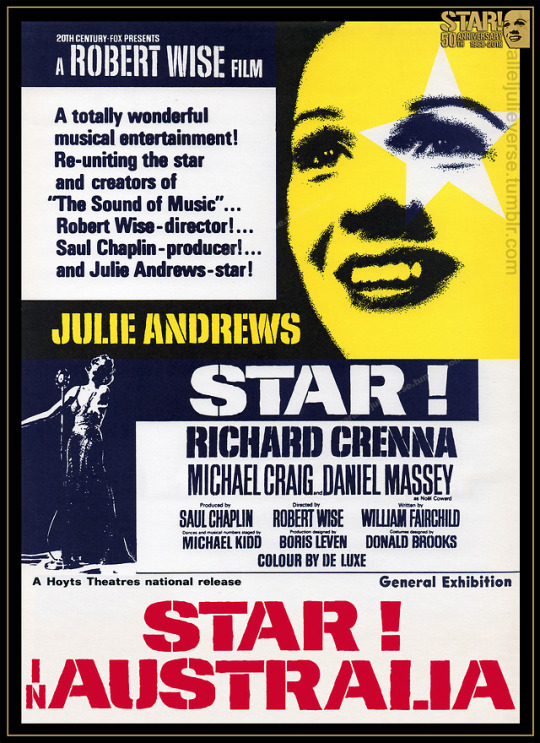
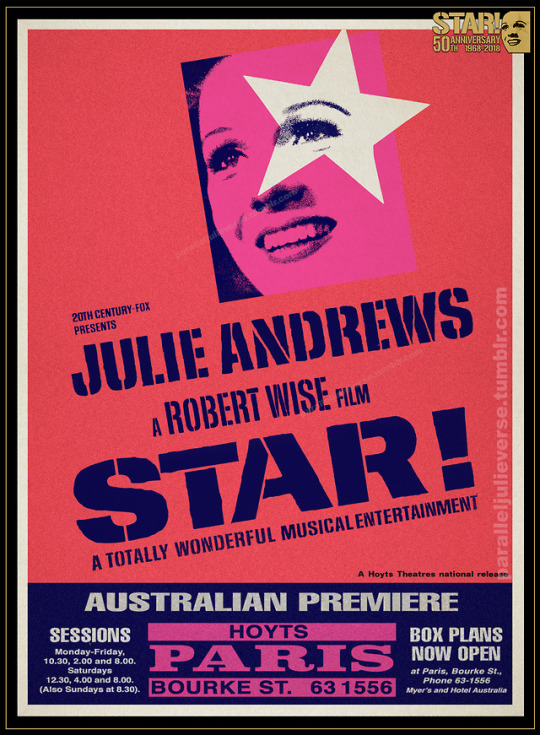



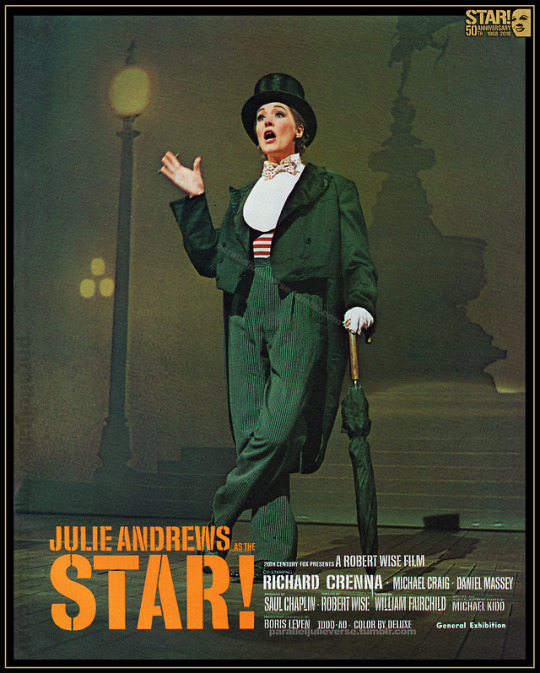
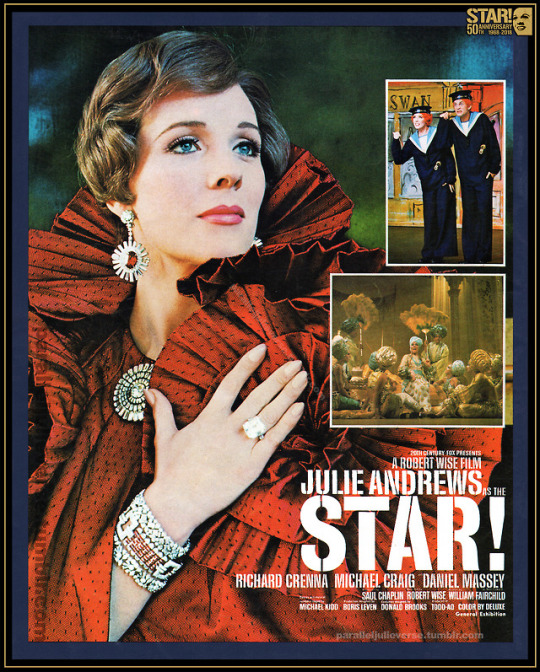

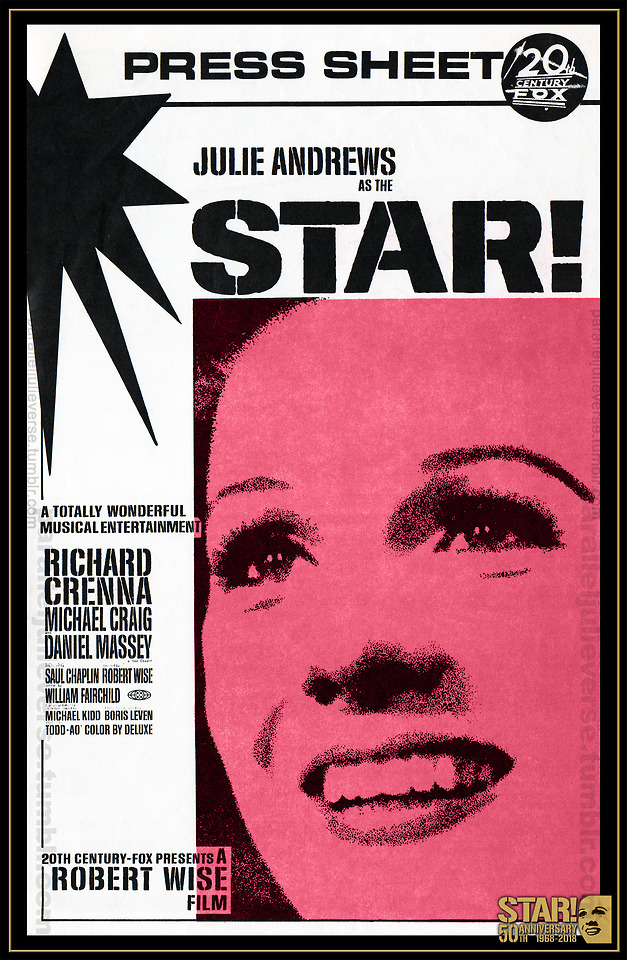
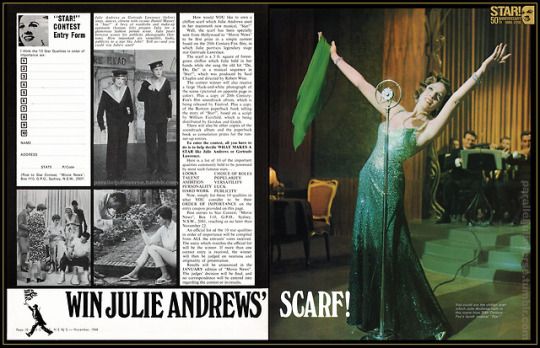
G’day Gertie: Star! debuts Down Under
After its global premiere in London and subsequent release to select international markets such as Japan, the Julie Andrews mega-musical Star! made its way to Australia in early-October 1968, fifty years ago this week. Release patterns for films in this era could be a little idiosyncratic, and the Australian release of Star! was no exception. The film was treated to two lavish “preview” premieres in Sydney and Melbourne on October 4 and 8, respectively, but didn’t open to the general public till October 24 with a premiere roadshow engagement at Melbourne’s Paris Theatre. Even more strangely, Melbourne was the only Australian city to screen Star! for the first six months. The film didn’t open in Sydney till 23 May 1969 with other Australian cities to follow.*
The three previous Julie Andrews film musicals –– Mary Poppins, The Sound of Music, and Thoroughly Modern Millie –– had all been major hits in Australia with Millie and Music still in theatrical release when Star! opened in late-1968. In point of fact, The Sound of Music enjoyed longer roadshow runs in Australia than anywhere else in the world: 181 weeks in Sydney (140 at the Mayfair before transferring to the Paris for a further 41 weeks), and 178 weeks in Melbourne (140 at the Paris, then transferring to the Esquire for a final 38 week run). By 1968, it was estimated that just under half the national population had seen The Sound of Music with more to come as the film entered suburban and regional release (Dale: 15; Keavney: 4-5).
As a result, Twentieth Century-Fox had high hopes Star! would do well in Australia and sent director Robert Wise on a special PR trip to the country to help launch the film. Accompanied by his wife, Patricia, Wise touched down in Sydney on 31 September 1968 where he was treated to a round of civic and industry receptions before officiating at a special gala invitation-only premiere of Star! on October 4 at Sydney’s Mayfair Theatre, home to The Sound of Music for so many years (“New Boom”: 18). The following week, Wise flew on to Melbourne for the second Australian premiere at the Paris Theatre, another Sound of Music alma mater, on October 8. While in Melbourne, Wise gave a host of press interviews and even helped the Lord Mayor lay a plaque for a new $4-million cinema complex in the city (Messer: 8; see also, Bennett: 14; Musgrove: 2; Veitch: 18).
As with the UK response, Australian critical reception of Star! was generally very positive. In Melbourne, Howard Palmer of The Sun wrote:
“Star! the Julie Andrews epic is indeed one of those films that a critic sees with relief, because he can let his his hair down and quite safely say it is wonderful in every way...Wise has put theatre on the screen better than anyone else before him...Julie Andrews gives the drama of the Lawrence love affairs so well...Add to this the many comic scenes of her early career....and you have a complete actress...It’s a wonderful film not to be missed” (27).
Alec Martin of the Melbourne Truth was equally enthusiastic:
“[I]f Gertrude Lawrence was alive today she would be the first to whistle and stamp her feet at...Miss Andrews’ brilliant performance in Star!...Miss Andrews sheds her wholesome Mary Poppins and Sound of Music image to play the glamorous, temperamental Gertrude Lawrence with perfection....Star! will be a box-office success, that’s for sure” (39).
Ronald Conway of Melbourne’s The Advocate declared Star! “[a]n agreeable, civilised musical...Julie Andrews sings and acts splendidly and it is a relief to see her in something other than Sound of Music which lasted at the Paris for ever so long...A handsome production to be enjoyed by patrons of all ages” (20). While Kay Mealun of The Australian Women’s Weekly gushed, “I found it rich and big and happy–– could have sat it through, three hours and all, all over again right away” (56).
Not all Australian reviews of Star! were as unreservedly laudatory, though even naysayers conceded the film had charm. Colin Bennett of The Age wrote that Star! “is well set in theatreland and reproduces...a series of splendid old favourites performed to perfection by Julie Andrews who looks fabulous and sings beautifully...But [she] lacks the bite of a Gertrude Lawrence. She is too fundamentally ‘nice’ and tasteful and efficient to be really insolent or bitchy” (6).
In a similar vein, Valda Marshall of The Sun Herald wrote:
“Star! is like an unrealised and long-forgotten musical script of the 30s...a conglomeration of vaudeville numbers, revue material and musical acts...It lacks a central sustaining interest [and] the star herself is without a unified character...Julie Andrews is...in top form. Her voice is as sure and strong as ever. Her acting still has the same unabashed directness and warmth. But the spark of mischievousness and spontaneity are missing” (87).
Charles Higham of the Sydney Morning Herald –– who summarily titled his mixed review, “Julie glitters but she isn’t Gertie Lawrence” –– declared Star! “a carefully made picture...with fine dramatic moments [but] there is something tame and bloodless about it...Julie Andrews in the title role...brings a brittle professionalism and impeccable coldness to a part that demanded vulnerability, anguish, a maddening neurotic edge. Impossible to imagine this athlete of the musical screen missing an appointment or failing to pay a bill, falling hopelessly and foolishly in love or singing out of tune” (6). Still, Higham mused in another column, “[o]ne hopes Sydney audiences will respond warmly to this very well-made film” (Higham: 19).
And, for the most part, Australian audiences did respond with comparative warmth to Star!. While the film didn’t score anywhere near the record-breaking success of The Sound of Music, it enjoyed respectable theatrical runs, playing in roadshow release in Melbourne for just under six months (23 weeks from 24 October 1968-26 March 1969) and in Sydney for five months (20 weeks from 23 May 1969-9 October 1969), two of the longest roadshow runs of Star! anywhere outside London (Davies: 198. 206; Louden: 6).
Star! also went on to a fairly solid theatrical after-life in Australia. The film avoided the debacle of post-release editing that occurred in North America and the full roadshow print screened in residual first release in suburban and regional Australian markets well into the early-70s. Star! even ran as a 70mm double-feature with Hello Dolly at Sydney’s Village Cinema City in late-1974. The film continued to pop up intermittently in subsequent years in repertory screenings. It played several times throughout the 1970s and 80s at Sydney’s Ritz and Mandarin cinemas. The National Library in Canberra hosted a special archival screening of Star! in March 1980, and the film was given a lavish one-week showcase season at Melbourne’s Astor Theatre in November 1998 to celebrate its 30th anniversary.
Star! was also a frequent feature on Australian TV screens. It made its national small screen debut as the Sunday Night Movie of the Week in October 1973 and was rebroadcast every few years thereafter: 1975, 1979, 1980, 1981, 1986 and 1989. As far as can be ascertained, the first two broadcasts were edited for running time, but most later broadcasts appear to have been the 176 min. roadshow release.
Notes:
* In a sign of the times, the delay of the Sydney release of Star! was due to the unexpected success of The Graduate which had been booked in to the Mayfair, Sydney’s “home” of Todd-AO roadshows. The theatre’s previous roadshow offering, Doctor Dolittle, closed earlier than anticipated and The Graduate was scheduled as a “filler” –– it ended up running at the Mayfair for 11 months (Louden, 6).
Sources:
Bennett, Colin. “Box Office Wisdom.” The Age Saturday Magazine. 5 October 1968: 14.
________. “New Films: Star.” The Age. 28 October 1968: 6.
Bishop, Barbara. “Julie Misses the Point.” The Sun. 25 October 1968: 14.
Conway, Ronald. “Star.” The Advocate. 31 October 1968: 20.
Dale, David. “The Tribal Mind: What Australians Love the Most.” The Sydney Morning Herald. 12 February 1999: 15.
Davies, Keith. 50 Years of Cinema and Movie’s in Melbourne’s CBD (1940 – 1989). Melbourne: (n.p.), 2016.
“Films on TV.” The Age Green Guide. 21 December 1978: 8.
Higham, Charles. “Star-Maker.” The Sydney Morning Herald. 5 October 1968: 18.
________. “Turmoil in Film City.” The Sydney Morning Herald. 24 May 1969: 19.
________. “Julie Glitters but she is not Gertrude Lawrence.” The Sydney Morning Herald. 26 May 1969: 6.
________. “Films like Mother Used to Cry Over.” The Sydney Morning Herald. 21 June 1969: 17.
Keavney, Kay. “‘The Sound of Music’ Greatest Film Bonanza.” The Australian Women’s Weekly. 36: 1, 5 June 1968: 4-5.
Louden, Doug. Sydney in 70mm. Sydney: (n.p.), 2016.
MacDonald, Dougal. “Julie Never Stops Being Julie.” The Canberra Times. 28 September 1969: 30.
Marshall, Valda. “It’s a Happening World: Star!” The Sun-Herald. 25 May 1969: 87.
Martin, Alec. “She is the True Star.” The Melbourne Truth. 2 November 1968: 39.
Melaun, Kay. “Julie as Gertrude.” The Australian Women’s Weekly. 36: 20, 4 December 1968: 56.
Messer, John. “From Horror to the Sound of Music––That’s Wise.” The Age. 8 October 1968: 8.
“Movies on TV.” The Sydney Morning Herald: TV Guide. 12 May 1975: 1.
“Movies on TV.” The Sydney Morning Herald: Monday Guide. 27 March 1978: 3.
“Movies on TV.” The Sydney Morning Herald: 7-Day Guide. 29 January 1979: 3.
“Movies on TV.” The Sun-Herald. 15 April 1984: 84.
Musgrove, Nan. “Two Women on His Mind.” The Australian Women’s Weekly. 36: 20, 16 October 1968: 2.
“New Boom for Star Musicals.” The Sydney Morning Herald. 1 October 1968: 18.
Palmer, Howard. “Julie Proves It.” The Sun Weekend Magazine. 26 October 1968: 27.
“Sunday TV.” The Age TV-Radio Guide. 30 March 1975: 8.
“Television.” The Age. 3 April 1980: 2.
“Television.” The Age. 28 August 1981: 2.
“Television.” The Age. 21 January 1989: 18.
“Today’s TV.” The Sun-Herald. 21 October 1973: 71.
Veitch, Jack. “Why Robert Wise Doesn’t Need to Work Again.” The Sun- Herald. 6 October 1968: 18.
“What Was the Name of that Film?” The Age. 8 October 1968: 16.
Copyright © Brett Farmer 2018
#julie andrews#Star!#star!50#gertrude lawrence#Robert Wise#Twentieth Century Fox#musical#old hollywood#fiftieth anniversary#classic film#australia#film poster#film advertising#hoyts
27 notes
·
View notes